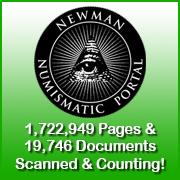
About UsThe Numismatic Bibliomania Society is a non-profit organization devoted to the study and enjoyment of numismatic literature. For more information please see our web site at coinbooks.org SubscriptionsThose wishing to become new E-Sylum subscribers (or wishing to Unsubscribe) can go to the following web page link MembershipThere is a membership application available on the web site Membership Application To join, print the application and return it with your check to the address printed on the application. Print/Digital membership is $40 to addresses in the U.S., and $60 elsewhere. A digital-only membership is available for $25. For those without web access, write to: Terry White, Treasurer AsylumFor Asylum mailing address changes and other membership questions, contact Terry at this email address: terrywhite5475@yahoo.com SubmissionsTo submit items for publication in The E-Sylum, just Reply to this message, or write to the Editor at this address: whomren@gmail.com BUY THE BOOK BEFORE THE COINSale Calendar
|
- WAYNE'S WORDS: THE E-SYLUM MARCH 28, 2018
- STOCKLEY EMAIL SALE CLOSES MARCH 26, 2018
- KOLBE & FANNING BUY OR BID SALE NUMBER 6
- NEW BOOK: CONFISCATION: GOLD AS CONTRABAND
- CIVIL WAR TOKEN ENGRAVERS INFORMATION SOUGHT
- COINTALK NUMISMATIC LITERATURE DISCUSSION
- CARNEGIE LIBRARY OF PITTSBURGH RARE BOOK THEFTS
- YORKSHIRE NUMISMATIST ADDED TO NEWMAN PORTAL
- NEWMAN PORTAL SEARCH: STARBURST EFFECT
- MORE ON READY’S BRITISH MUSEUM REPLICAS
- A SILVER CAPE COD CANAL COMPLETION MEDAL
- NOTES FROM E-SYLUM READERS: MARCH 25, 2018
- MORE ON THE POLISH MILLENNIUM MEDAL
- MORE ON GUTTAG BROTHERS TOKENS
- VOCABULARY TERMS: BULLION COIN AND MEDAL, NCLT
- HARRY BENNETT WILBER (1872-1945)
- HARVEY STACK'S NUMISMATIC FAMILY, PART 14
- BRITISH INDIA GEORGE VI QUARTER ANNA VARIETIES
- MINNEAPOLIS MARCH 2018 YOUNG NUMISMATIST EVENT
- THE A & A SAINTS COLLECTION OF DOUBLE EAGLES
- NUMISMATIC NUGGETS: MARCH 25, 2018
- SELECTONS FROM STACK'S BOWERS MARCH 26, 2018 SALE
- WAYNE'S NUMISMATIC DIARY: MARCH 25, 2018
- DENNIS TUCKER'S MARCH 2018 BALTIMORE BLOG
- SIGNIFICANT ROMAN COIN FIND IN NORFOLK
- NETHERLANDS WORKERS UNCOVER COIN HOARD
- CHINA'S "L. GIORGI" PATTERN TEN CASH COIN
- CANADIAN NATIONAL INSTITUTE FOR THE BLIND COIN
- SCARINCI ON THE BREAST CANCER AWARENESS COIN
- DAVID J. RYDER CONFIRMED AS MINT DIRECTOR
- WSJ QUESTIONS NEED FOR CENTS AND NICKELS
- PHILADELPHIA TOKEN PHASEOUT NEARS COMPLETION
- BARRON'S ARTICLE HIGHLIGHTS ANDERSON PAPER MONEY
- ARTICLE PROFILES BLAIR, NB $10 NATIONAL BANK NOTE
- VENEZUELA PONDERS DROPPING THREE ZEROS
- IN OTHER NEWS: MARCH 25, 2018
- FEATURED WEB PAGE: VIET NAM NUMISMATIC CLUB
Click here to access the complete archive
To comment or submit articles, reply to whomren@gmail.com
Content presented in The E-Sylum is not necessarily researched or independently fact-checked, and views expressed do not necessarily represent those of the Numismatic Bibliomania Society.
WAYNE'S WORDS: THE E-SYLUM MARCH 28, 2018
 Check out our updated numismatic literature sale calendar at the right of this article (at the top of each full issue). Dealers Kolbe & Fanning have scheduled their sales #149 and
#150 for April 28 and July 14, respectively. Alan Workman, the Florida bookseller who acquired the numismatic literature business of the late Fred Lake, will hold his first sale with a planned
closing date of May 19th. Use this link to get on his email list for announcements: http://eepurl.com/r3muv . Alan writes:
Check out our updated numismatic literature sale calendar at the right of this article (at the top of each full issue). Dealers Kolbe & Fanning have scheduled their sales #149 and
#150 for April 28 and July 14, respectively. Alan Workman, the Florida bookseller who acquired the numismatic literature business of the late Fred Lake, will hold his first sale with a planned
closing date of May 19th. Use this link to get on his email list for announcements: http://eepurl.com/r3muv . Alan writes:
As it stands right now, this sale is going to have a large number of books on banking history, NY county histories, paper money, U.S. coinage, ancients, treasure, and pirates. Should be something for everyone! My goal is to have my website updated and the auction uploaded to iCollector by the middle of April.
This week we open with two numismatic literature sales, one new book, a call for information, and word of a major rare book theft.
Other topics this week include the Starburst Effect, the Cape Cod Canal medal, bullion coins, double eagles, the Whitman Baltimore Coin Expo, the U.S. Mint, and Venezuela's coin and banknote changes.
Also, Arash Ilavia submitted an original article on obverse varieties of the British India George VI Quarter Annas of 1938 and 1939.
To learn more about the W. W. C. Wilson collection, gold as contraband, the Mount Vernon Club, engraved portraits of Washington, left-handed riflemen, the Selinos tetradrachm, William and Charles Barber, Redbook cookies, and Howard Daniel's Vietnamese Money Wallet, read on. Have a great week, everyone!
Wayne Homren
Editor, The E-Sylum
STOCKLEY EMAIL SALE CLOSES MARCH 26, 2018
Bids are accepted by email only. Richard's address is rstockley@videotron.ca . He can provide more information and images on request. -Editor


Lot #1 Canadian Antiquarian & Numismatic Journal Vol V 1876 #1-4, 196 pgs, hard bound in 1 vol, ¼ leather, plates of the Cuvillier scrip along with the article by McLachlan, 3 other articles on medals also by him. Covers are very worn, contents are tight & clean, inside has sticker “M. A. STE MARIE / #0498” Starting price $50
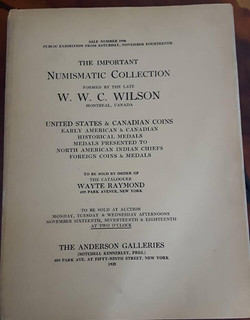
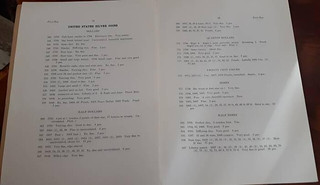
Lot #2 Wayte Raymond auction # 1996 sale of nov 16-18, 1925, The W. W. C. Wilson collection of U.S. & Canadian coins, tokens, historical and Indian Chief medals etc an important sale with prl. Has the 2 halftone plates mentioned below. Covers & spine are faded with a few chips, Starting $50
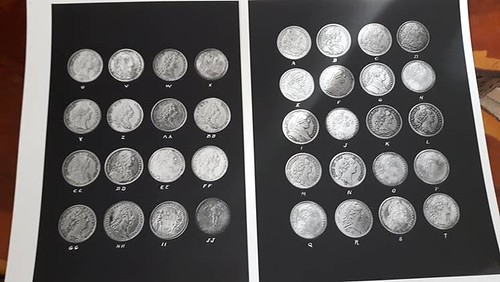
Lot #3 2 photographic plates from the above sale commissioned in 1997 by Ford. Auctioneer’s description “a lot of 2 photographic prints made from the negatives that created the halftone plates found in some versions of the 1925 Wilson sale..” His estimate $75 Starting $30
Richard Stockley
39 ch. Senneville,
Senneville, QC
Canada H9X 1B8
KOLBE & FANNING BUY OR BID SALE NUMBER 6
Kolbe & Fanning Announce Buy or Bid Sale #6 Through April 6
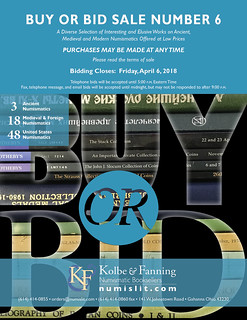 Kolbe & Fanning Numismatic Booksellers have announced their sixth “Buy or Bid Sale,” which begins now and will close on Friday, April 6. The sale focuses on modestly priced books, giving
collectors an opportunity to add to their libraries at minimal cost.
Kolbe & Fanning Numismatic Booksellers have announced their sixth “Buy or Bid Sale,” which begins now and will close on Friday, April 6. The sale focuses on modestly priced books, giving
collectors an opportunity to add to their libraries at minimal cost.
There will be no printed catalogue. The PDF catalogue is available now for downloading from the Kolbe & Fanning website at numislit.com .
As the name of the sale suggests, customers may bid on items they wish to acquire or buy them outright at the published price. The Terms of Sale will give full instructions on how to participate: please read it carefully.
The sale includes over 1400 works on ancient, medieval and modern coins, as well as general works, periodicals and sale catalogues. “Buy” prices have been kept low to promote sales. To further encourage participation, the firm is offering free domestic shipping to bidders spending at least $500; there will also be no packing and processing fee for this sale. Again, please read the Terms of Sale before participating.
If you have any questions about the sale, please write the firm at orders@numislit.com .
Thank you in advance for your participation. Download the sale today: numislit.com .

NEW BOOK: CONFISCATION: GOLD AS CONTRABAND
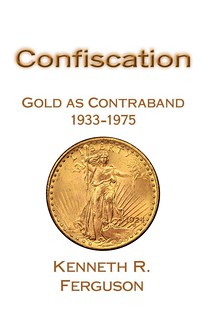 Professional numismatist Kenneth R. Ferguson has released a new book on the confiscation of gold from American citizens between 1933 and 1975. Though this interlude in history is often
overlooked or downplayed by both historians and economists, its significance to the modern coin dealer can't be overstated.
Professional numismatist Kenneth R. Ferguson has released a new book on the confiscation of gold from American citizens between 1933 and 1975. Though this interlude in history is often
overlooked or downplayed by both historians and economists, its significance to the modern coin dealer can't be overstated.
Ferguson takes readers step-by-step through the legal precedents established by President Roosevelt -- some of which remain on the books to this day -- and offers expert analysis on the ongoing and future relationship between gold and government.
"Confiscation: Gold as Contraband 1933-1975" is available now for $11.99 on Amazon.com. For a direct link, click here: http://amzn.to/2Gd2N5W .
Kenneth R. Ferguson received his master’s degree from the Lyndon B. Johnson School of Public Affairs at the University of Texas at Austin in 1973. He made his living as a professional coin dealer for over 40 years, serving as both President of the Texas Coin Dealers Association and Consultant to the American Numismatic Association. He has lived in Austin since 1966.
For more information, or to order, see:
http://kennethrferguson.com/
CIVIL WAR TOKEN ENGRAVERS INFORMATION SOUGHT
Dave Bowers on behalf of the Civil War Token Society is nearing completion of a manuscript, Engravers and Minters of Civil War Tokens. Unlike certain other areas of American numismatics—colonial and early American copper coins being examples—much about the engravers of Civil War tokens and their mintage and distribution is unknown, this being especially true for some of the more obscure artisans and shops.
Dave is seeking biographical and numismatic information on these engravers in particular:
Louis Roloff, of New York City, who made and signed many tokens. Little is known about his biography—place of birth, time of death, education, family, and the like.
V.R. Allen and Charles Ulrick (or Ulrich). These two engravers were mentioned by Henry Clay Ezekiel in “Cincinnati’s Civil War Tokens,” The Numismatist, July 1911. Ezekiel lived in Cincinnati, and during the Civil War he paid frequent visits to the shops of Lanphear, Stanton, and others and, presumably, say Allen and Ulrick engaged in engraving. Allen was a stencil maker, but nothing has been found about his activities in Cincinnati 1861-1865. Ulrick remains a complete mystery.
Mossin & Marr in Milwaukee and F.C. Key & Son in Philadelphia were well-known in their time and made tokens during the Civil War. It seems that slightly after the war, John Marr on his own and F.C. Key & Sons acquired dies made by other shops and made restrikes and mulings of them. Does anyone have any information about these.
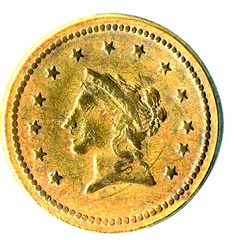

In Baltimore the Shakespeare Club was active by 1866 and held meetings in Bellevue Gardens on West Baltimore Street in Baltimore, a pleasure ground that was home for picnics, military unit rallies, and more. The Mount Vernon Club issued tokens that were similar in design. Does anyone have any information about the activities of either during the years 1861 to 1865?
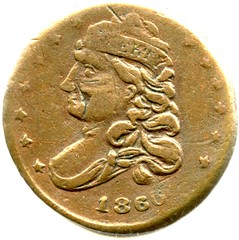
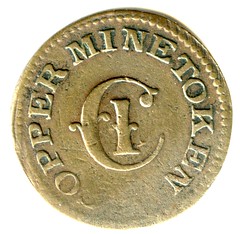
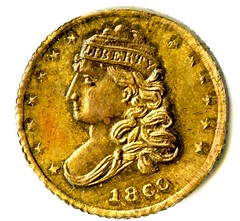

A first-class mystery surrounds the pieces lettered SILVER MINE TOKEN and COPPER MINE TOKEN combined with various other dies, included a Capped Bust portrait die of 1860. These dies were later in the hands of A.W. Escherich, by which time they had rim breaks. Does anyone know about the origin of either?
Also, if anyone has invoices by which merchants and others ordered tokens in quantity during the Civil War these would desirable to see.
Your “reward” is appreciation by Dave and a credit in the book. Contact: Dave Bowers, qdbarchive@metrocast.net .
COINTALK NUMISMATIC LITERATURE DISCUSSION
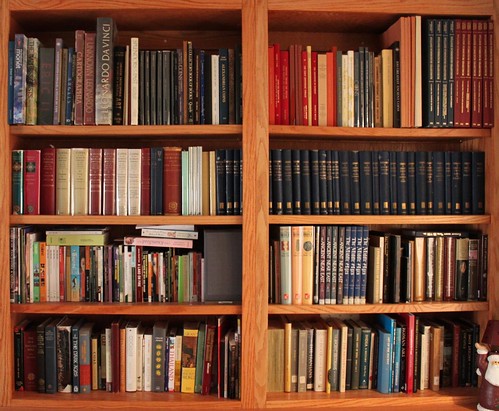
To read the complete thread, see:
Post Your Numismatic Literature! (https://www.cointalk.com/threads/post-your-numismatic-literature.228947/)

CARNEGIE LIBRARY OF PITTSBURGH RARE BOOK THEFTS
On the Numismatic Bibliomania Society Facebook page, former Editor of The Asylum Tom Fort writes:
A major theft (or series of thefts) from the principal public library in Pittsburgh. From the list, which the Pittsburgh Post-Gazette published below, no numismatic books seem to have been taken. However, I do know that the library holds a number of numismatic items, most famously a complete set of The Numismatist, including the rare first six volumes.
Charles Henry Hart, Catalogue of the Engraved Portraits of Washington, New York: Grolier Club, 1904; Of 425 copies
Lorado Zadoc Taft (American, 1860 - 1936), Medal Struck in Celebration of the Sixty-Sixth Anniversary of the Birth of James Whitcomb Riley, 1916; #219 of 500
Here's an excerpt from the article. -Editor

Valuable atlases, maps, and large plate books that show the colorful breadth of Western civilization have been stolen from the rare books room of the Carnegie Library of Pittsburgh in Oakland, right under the gaze of Andrew Carnegie’s portrait.
The theft of 314 items was discovered last April when an appraisal for insurance purposes began of the rare materials in the Oliver Room, library spokeswoman Suzanne Thinnes said. Deemed a crime scene, the room has been closed since April 3, 2017. Since that time, detectives from the Allegheny County District Attorney’s Office have been investigating the complex case.
“We’re very saddened by the breach of trust. This theft occurred over an extended period of time” by a knowledgeable individual or individuals, Ms. Thinnes said. She said the library could not provide an exact value of the missing materials.
Michael Vinson, a rare book dealer for 26 years, who reviewed a detailed list of the missing items, was more direct.
“I think the value would easily be $5 million. This is an immense cultural crime,” he said.
Among the missing books is a first edition of Isaac Newton’s “Philosophiae Naturalis Principia Mathematica” from London, dated 1687. Mr. Vinson noted that another copy of this book sold for $3.7 million in 2016 at a Christie’s auction in New York City.
Also gone is a first edition of Adam Smith’s book “The Wealth of Nations,” which, Mr. Vinson said, would be worth $150,000. Nine books printed before 1500 were stolen, too. These texts are called incunables because they were printed in the first 50 years after Johannes Gutenberg began printing. Mr. Vinson said the nine incunables would be worth a total of $50,000.
“This is a great loss to the Pittsburgh community,” she added. “Trust is a very important component of what we do on a daily basis. The library takes very seriously the security of all its collections.”
The staff member responsible for the collection is no longer employed by the library, she said, declining to elaborate.
“This was part of a magnificent collection that would cover the entire breadth of Western civilization. [Edmund] Spenser’s ‘The Faerie Queene’ is a landmark in literature,” said Mr. Vinson, who lives in Santa Fe, N.M. and holds a master’s degree in library science from the University of Chicago, where he specialized in the history of the book.
The list, obtained by the Pittsburgh Post-Gazette, includes a first folio edition of Spenser’s classic poem that was published in London in 1609.
A three-volume set by Thomas L. McKenney and James Hall, titled “History of The Indian Tribes of North America,” is worth $100,000, Mr. Vinson said.
Also missing is John James Audubon’s oversized book “The Quadrupeds of North America,” an octavo edition of his illustrations of four-footed mammals published in the 1850s in New York City.
Joyce Kosofsky, co-owner of Brattle Book Shop in downtown Boston, has worked in the book trade since 1978 and agreed with Mr. Vinson. She called the list “jaw-dropping. It’s an impressive list of books — the range of what’s there,” she said.
“These are high-end rare books. I’ve never seen a list this big. This is a major theft,” Ms. Kosofsky said.
Unless there has been a name change, there are at least two rare book rooms - Oliver and Wadsworth. The numismatic literature was shelved in the Wadsworth room.
Back in 1989, during the American Numismatic Association convention in Pittsburgh I arranged a numismatic bibliophile visit to the Carnegie Library Wadsworth Rare Book Room. Pictured left to right are: Mark Auerbach, George Kolbe, Wayne Homren (a young me), Frank Katen, Ken Lowe, Myron Xenos, John Bergman, and Armand Champa.

Curious, I looked for an example of the James Whitcomb Riley medal - I'd never heard of either the medal or the book. I found one in the numismatic collection of the Yale University Art Gallery. -Editor
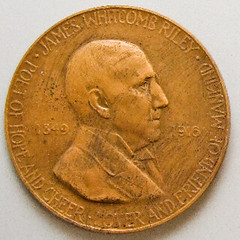
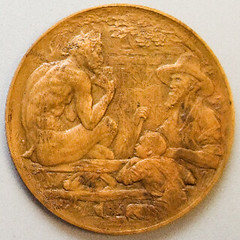
To read the conplete Yale University inventory entry, see: Bronze medal of James Whitcomb Riley (https://artgallery.yale.edu/collections/objects/165226)
To read the Carnegie Library numismatic literature inventory on the Newman Numismatic Portal, see:
Wayne Homren Archives: 1991 Carnegie Library of Pittsburgh Wadsworth Room Numismatic Literature Appraisal
(https://nnp.wustl.edu/library/book/538819)
To read the earlier E-Sylum article, see:
PHOTO ARCHIVE: NUMISMATIC BIBLIOPHILES VISIT CARNEGIE LIBRARY RARE BOOK ROOM (http://www.coinbooks.org/esylum_v11n22a05.html)
To read the complete Post-Gazette article, see:
Who stole 314 items from the Carnegie
Library rare books room? (http://www.post-gazette.com/ae/books/2018/03/19/Carnegie-Library-rare-atlases-maps-books-Japanese-prints-stolen-Oliver-Room/stories/201803190007)
For more information, see: Pittsburgh Area Thefts (https://www.abaa.org/blog/post/pittsburgh-area-thefts
YORKSHIRE NUMISMATIST ADDED TO NEWMAN PORTAL
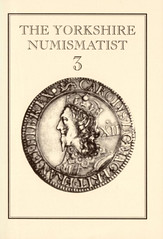 The Yorkshire Numismatic Society (Leeds, UK) has contributed four volumes of the Yorkshire Numismatist for inclusion on Newman Portal. These volumes, periodically published since
1988, gather scholarly articles on ancient, medieval, and modern numismatics with an emphasis on Anglo-Saxon and English material.
The Yorkshire Numismatic Society (Leeds, UK) has contributed four volumes of the Yorkshire Numismatist for inclusion on Newman Portal. These volumes, periodically published since
1988, gather scholarly articles on ancient, medieval, and modern numismatics with an emphasis on Anglo-Saxon and English material.
Volume 4 (2012), for example, contains an article by Adrian Marsden that discusses a hoard of 65 Anglo-Saxon sceattas unearthed by a metal detectorist in 2010. Tony Abramson, president of the
Yorskhire Numismatic Society, provides background on the sceatttas:
“They were silver early-pennies of 10-11mm in diameter, weighing c. 1.10g in the primary phase (660s-c. 710) and c. 1.00g in the secondary phase (c. 710 to 750s in the south of England, the Low Countries and France, and into the 9th century in north England and Ribe). Those of the north of England are inscribed with the names of issuers and moneyers. Southern issues are typically uninscribed.”
Marsden’s article catalogs and analyzes the varieties found and provides additional historical background. The Newman Portal is grateful to Tony Abramson for facilitating this contribution.

Image: Sceattas from the Aldborough (Norfolk) hoard.
Link to the Yorkshire Numismatist on Newman Portal:
https://nnp.wustl.edu/library/publisherdetail/525351
NEWMAN PORTAL SEARCH: STARBURST EFFECT
This week a Newman Portal user searched for the term “starburst effect.” While Newman Portal searches are anonymous, the search terms themselves are logged. Newman Portal delivers but a single result for this term, but the definition comes straight from the U.S. Mint. In the Fall 2013 issue of The Centinel, Steve Bieda wrote an important article on U.S. Mint coinage dies produced in conjunction with the 1996 Olympic Games held in Atlanta, and, as part of his research, found an 1997 Coin World article explaining the situation. Bieda writes:
A vast majority of the Olympic dies sold by the Mint were taken out of service because of what the Mint called “starburst.” “The starburst effect is so named because it looks like a starburst gemstone,” according to George E. Hunter, then assistant U.S. Mint director for process and quality control, in a 1997 Coin World interview. “Its design is radial, though not perfectly radial, and occurs in the direction of the metal flow.”
The starburst effect is caused by abrasive particles that build up and then etch the die as they are carried outward from a central point in the direction of metal flow during successive strikes. It was the primary reason for removing most of the dies used to strike proofs, and among the Olympic dies sold to collectors, was the reason more than two-thirds of the dies were taken out of service.
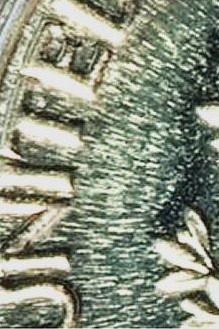 In this case, picture is worth a thousand words, and this image, courtesy of Roger Burdette (from United States Proof Coins 1936-1942) demonstrates the effect on a proof Mercury
dime. “Starburst effect” is commonly seen on U.S. proof coins following the recommencement of proof coinage in 1936. Production techniques improved in time and today anything but a perfect, smooth
mirror would be a disappointment.
In this case, picture is worth a thousand words, and this image, courtesy of Roger Burdette (from United States Proof Coins 1936-1942) demonstrates the effect on a proof Mercury
dime. “Starburst effect” is commonly seen on U.S. proof coins following the recommencement of proof coinage in 1936. Production techniques improved in time and today anything but a perfect, smooth
mirror would be a disappointment.
Roger Burdette adds:
"Starburst" on a die is even more extreme looking than on the photo.
Link to The Centinel on Newman Portal:
https://nnp.wustl.edu/library/book/513721?page=53

MORE ON READY’S BRITISH MUSEUM REPLICAS
“The prices set on 10 June 1882 were:
Full set of Greek coins (800 pieces) £125
Selection of finest coins with some Roman (400 pieces) £70.
Selection of Classical Greek coins (200 pieces) £33.
Selection from plates in the Guide (87 pieces) £14.
Single electrotypes, according to page viii of the Guide cost 2 shillings and 6 pence each.
(signed) Martin Price.”
(A photocopy reports that: Mr Ready, electrotypist, British Museum, supplies single electrotypes (obverse and reverse) of any of the coins described in the Guide, at 2 shillings and 6 pence each. Complete sets for Museums, schools etc, classified and labelled, in cases lined with velvet, as in the British Museum, can also be obtained from him. The Guide is – “Department of Coins and Medals. A guide to the select Greek and Roman coins exhibited in electrotype. 1880”).
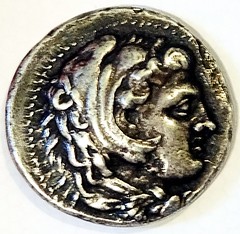
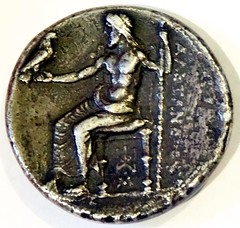
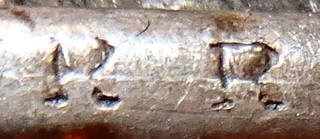
Tetradrachm, Alexander the Great, 33mm
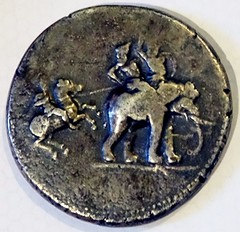
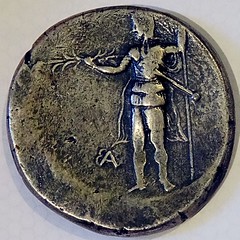
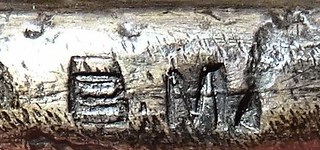
Tetradrachm, Alexander and King Porus, 35mm
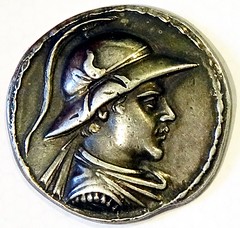
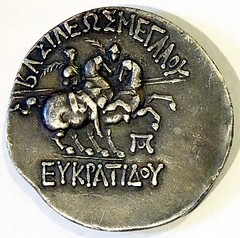
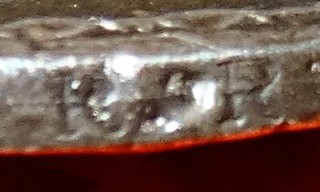
Ready copy Tetradrachm, Eukratides I of Bactria, 33mm
To read the earlier E-Sylum article, see:
ROBERT READY’S BRITISH MUSEUM REPLICAS (http://www.coinbooks.org/v21/esylum_v21n11a12.html)
A SILVER CAPE COD CANAL COMPLETION MEDAL
A web site visitor writes:
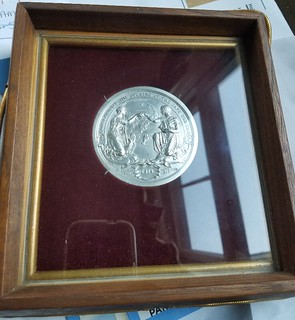 My name is Peter Thomas and I live on Cape Cod. In 2006 you bantered back and fourth with Mr Lee Childs, a jazz musician on a cruise boat who overpaid for a bronze 1914 canal commemorative
coin made by Reed and Barton and said there was a rumor of 25 in silver.
My name is Peter Thomas and I live on Cape Cod. In 2006 you bantered back and fourth with Mr Lee Childs, a jazz musician on a cruise boat who overpaid for a bronze 1914 canal commemorative
coin made by Reed and Barton and said there was a rumor of 25 in silver.
I have discovered an article which talks of two in gold (Governor of Mass and Mr Belmont) and 24 in silver of which this is one...walnut case and engraved to a friend of my Dad's father who was a principal engineer on the canal,
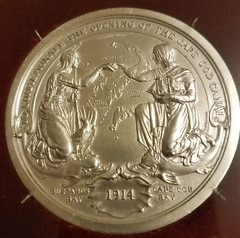
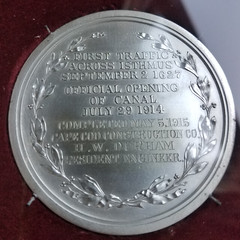
To read the earlier E-Sylum articles, see:
CAPE COD WATER CHANNEL MEDAL SOLD (http://www.coinbooks.org/esylum_v09n34a17.html)
CAPE COD MEDAL NOT RARE (http://www.coinbooks.org/esylum_v09n35a19.html)
CAPE COD CANAL MEDAL FOLLOW-UP (http://www.coinbooks.org/esylum_v09n40a06.html)
NOTES FROM E-SYLUM READERS: MARCH 25, 2018
The Five Elizabeth Queens of England
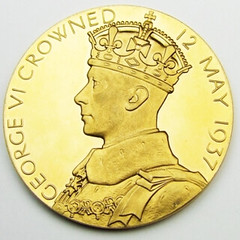
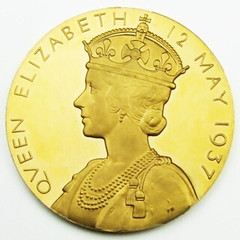
Philip Mernick of London writes:
When you showed the beautiful gold 1937 coronation medal you said “No, not THAT Queen Elizabeth, the first one. “ Readers might find it interesting that Elizabeth Bowes-Lyon wife of George VI was in fact the fourth of five Elizabeth Queens of England.
Only two have been Queen in their own right Elizabeth I (1558-1603) and Elizabeth II (from 1952) but three others have been Queen by marriage. Elizabeth Woodville wife of Edward IV, Elizabeth of York, wife of Henry VII and the aforementioned Elizabeth Bowes-Lyon wife of George VI.
To read the earlier E-Sylum article, see:
NUMISMATIC NUGGETS: MARCH 18, 2018 : 1937 King George VI and Queen Elizabeth Coronation Gold Medal
(http://www.coinbooks.org/v21/esylum_v21n11a21.html)
Howard Daniel's Vietnamese Money Wallet
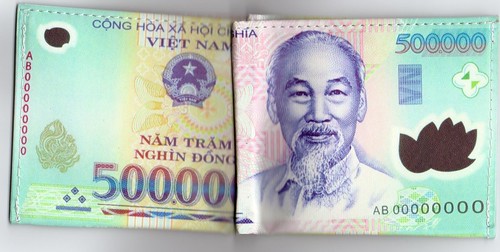
Howard Daniel writes:
Several years ago, many young Vietnamese numismatists asked me to create a Facebook page. I really did not want to do it but they wanted me to post my new information/pieces there so they could learn about them. After a little more nudging, I agreed and signed up. Within a month or so, I had several hundred Vietnamese numismatists as my friends! I was shocked. Now I have well over 1000. Now these new young numismatists post more information/pieces than I have time to do.
During my recent two months in Viet Nam I stayed at Sedona Suites above the large Saigon Centre Mall in District 1 in Ho Chi Minh City. While going through the more recent posts from my friends, I spotted one entry with a 500,000 Dong bank specimen note in color as the design across an entire wallet.
I asked the young man where I could buy it and he told me he would give one free to me if I came downstairs in about 30 minutes and stood outside the mall entrance on Pasteur street. I agreed and he appeared and gave me the wallet. I tried to pay him for it but he refused and took off on his motorcycle.
The design is what is used by the State Bank of Viet Nam and is not a specimen available to collectors. Later, the young man sent me many images of other wallets with paper and polymer notes on them, to include a US 100 Dollars note. They are professionally done and can actually be used as a wallets but I have put mine in my Socialist Republic of Viet Nam collection.
More on the Origin of the Word "Znachki"
ANA Edition reader Axel Kornfuehrer of Hopkins, MN writes:
I have a further comment about the Russian word "znachki" referenced in The E-Sylum. The word "znachki" is the plural of "znachok", which means both "mark" and "badge". And "badge" would be the translation when refering to these Soviet tinnies. It is probably linguistically related to the word "znak", meaning "sign", as the writer notes in the E-Sylum comment. (Source Smirnitzky's Russian-English Dictionary.)
To read the earlier E-Sylum article, see:
NOTES FROM E-SYLUM READERS: MARCH 18, 2018 : Origins of the Word "Znachki"
(http://www.coinbooks.org/v21/esylum_v21n11a10.html)
More on Obsolete Computer Files
Regarding obsolete computer files, An ANA Edition reader writes:
Please let me introduce myself. My name is Levin Messick and I have been a collector of obsolete banknotes since 1954. My area of interest is Maryland. I was a contributor to Denwood Kelly's book Money and Banking in Maryland and most recently the editor of volume 8 Maryland notes for Dave Bower's Obsolete Paper Money series. I also collect ancient coins and have most of the Roman Emperors and many of their wives except for the last few bums of the month from 455-476. I also have a nice selection of Greek and Bactrian coins.
As an ANA member I want you to know how great it is to be able to receive your publication. You do a singular job in bringing together a publication that I avidly await to see what is next. I must say that I believe books are not going away soon. While our digital age is a marvel it is transient. Computer wonkies just don't get that the past needs to be preserved; they can only see what is in front of them.
I worked many years as a trust appraiser and discovered early on that when I needed to go back more than a year's worth of property sales that they had been dumped by the computer folks. When I called to complain a bright young fellow said "Why would you possibly want that old stuff"? My reply was I did not need it for me but the IRS did and if they could not retrieve the information it could cost my client several millions of dollars. Said client might then take out his ire on them. So, I found the article on the recovery of information on old discs of more than passing interest.
Martin Purdy of New Zealand writes:
In the 1970s and early 80s I made a card index file for all my coin purchases, which worked well for a few years, though it started to grow pretty big in the end. In the mid-1980s I lived in Japan while my card index (and coins) stayed in New Zealand. I bought a new-fangled word-processor while there (one that showed about three lines at a time on its mini-screen but allowed files to be saved, printed and stored to 3.5" disk).
You can see where this is heading - I logged all my new purchases on the new machine and saved it all to disk, and when I came home I laboriously transcribed all the old cards onto data files on disks, then burned the cards. Of course, the file system was maker-specific (Toshiba?) and the disks can't even be opened on a Windows system. I still have the disks, 30 years later, and realistically, any information on them will be totally out of date now and not worth going to any expense over. But a lesson learned, all the same ... I think! My numismatic and book lists are all on generic Excel files now (no more proprietary tools for me), and I hope I can at least transfer them to any successor program in good time if the need should ever arise.
To read the earlier E-Sylum article, see:
RECOVERING OLD OBSOLETE COMPUTER FILES (http://www.coinbooks.org/v21/esylum_v21n11a16.html)
On the Purported 16th Century Coin Cabinet
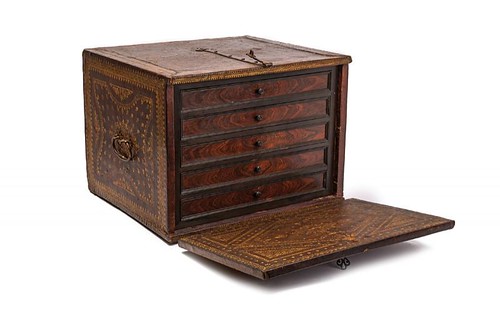
Regarding the purported 16th century coin cabinet, Arthur Shippee of Hamden, CT writes:
This looks a lot like the mah-jongg cabinet mother had, doesn’t it? Without positive evidence of the contents, I don’t see how we can deduce its particular function.
His brother Bob Shippee of Colorado Springs, CO adds:
Yes, it looks a bit like our mother's mahjong cabinet, but it's clearly not Chinese, so I suspect it had a different use. I agree with Wayne -- the drawers look too thick to be used for coin storage. My guess is it's a jewelry box.
To read the earlier E-Sylum article, see:
A 16TH CENTURY COIN CABINET? (http://www.coinbooks.org/v21/esylum_v21n11a20.html)
Another Sacajawea Mouse Pad
Donn Pearlman of Las Vegas, NV writes: 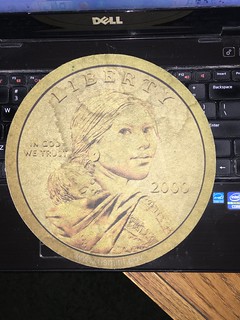
I have not yet retired my United States Mint 2000 Sacajawea mouse pad. She continues to guide me through the wilderness of various writing projects.
To read the earlier E-Sylum article, see:
WAYNE'S NUMISMATIC DIARY: MARCH 18, 2018 : Mouse Pad Mania (http://www.coinbooks.org/v21/esylum_v21n11a23.html)
The 2018 WWI Centennial Dollar Design Questioned
ANA Edition reader Lev Messick writes:
I enjoyed the information about the process of selection of commemorative coins for the American Legion. They as a group have helped me to gain recognition of my service connected disabilities after years of stonewalling by the VA. They are a great organization and most deserving of the honor.
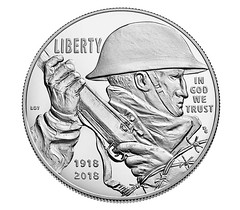 When reading the American Legion article I noticed the mint ad next to it. Has anyone other than me noticed that the soldier on the WWI Centennial Dollar is left handed? I can't speak
for the army as I am a Navy vet. All of us were trained to bear arms right handed as well as shoot right handed. The two rifles of WWI were bolt action 30-06 Springfield or Eddystone Enfield rifles.
They are designed to be used right handed. It just might be a little dangerous to have a lefty next to you in a formation or shooting step line. I know because I am a lefty.
When reading the American Legion article I noticed the mint ad next to it. Has anyone other than me noticed that the soldier on the WWI Centennial Dollar is left handed? I can't speak
for the army as I am a Navy vet. All of us were trained to bear arms right handed as well as shoot right handed. The two rifles of WWI were bolt action 30-06 Springfield or Eddystone Enfield rifles.
They are designed to be used right handed. It just might be a little dangerous to have a lefty next to you in a formation or shooting step line. I know because I am a lefty.
Another way of looking at this is that lefty diners are generally seated at the top left and bottom right seats so that they don't bang elbows with fellow diners. You don't get preferred seating in a trench. Imagine banging elbows while loading, cocking, and firing rifles under fear and stress! Maybe the artists at the mint and the Commission of Fine Arts should consult with a military person when designing such coinage.
To read the earlier E-Sylum article, see:
THE AMERICAN LEGION COIN DESIGN PROCESS (http://www.coinbooks.org/ana/ana_esylum_v02n12.html#article18)
French Issues in the East Indies
Howard Daniel writes:
One of your Numismatic Nuggets of January 14, 2018 is a piece I have put on page 187 of my upcoming 3rd edition of French Southeast Asia Coins & Currency catalog, which will be printed this month. The many French coins and paper money issues in the East Indies are not often cataloged and they are in my catalog for the first time. It was a major oversight of mine not to include them in the earlier editions.
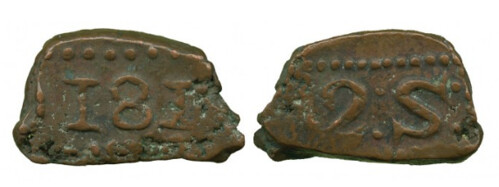
Batavia, under French rule, copper bonk 2 stuivers, 1810, 6.31g (Sch 569).
To read the earlier E-Sylum article, see:
NUMISMATIC NUGGETS: JANUARY 14, 2018 : 1810 Batavia Copper Bonk 2 Stuivers (http://www.coinbooks.org/v21/esylum_v21n02a23.html)
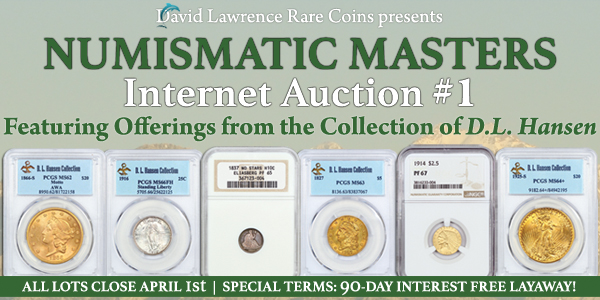
MORE ON THE POLISH MILLENNIUM MEDAL

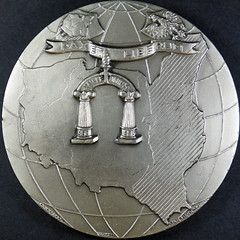
Chip Howell of Pasadena, MD writes:
(1) The outline of Poland includes the eastern part which was annexed to the USSR at the end of WW2 (oblique shading), so I doubt it was done behind the Iron Curtain, to remind the Poles what happened there;
(2) I assumed STAN(ISLAUS) KUPOLSKI was the engraver's name, but parsing it "STAN KU POLSKI" yields "State towards Poland" in Google Translate--clunky, but fragmentary. The other writing I cannot read from the image, might supply missing grammatical context (e.g., "...Poland becoming a state");
(3) Speaking of "Google Translate," might not a better rendering of MILLE ANNOS AMORIS PATRIAE be "A Thousand Years of Love of Country"? 1966 is also regarded as the millennium
of the Polish state. See this Wikipedia entry:
https://en.wikipedia.org/wiki/Christianization_of_Poland
#Millennial_celebrations_of_1966 . I leave that to Latin scholars to determine.

Chris Bower writes:
I also assumed STAN KUPOLSKI was the engraver because it was located in a logical, to me, spot for a signature. My feeling is that is more likely a medal for the millennium of the state rather than Christianity simply because it doesn't have a religious vibe to it. I know, that's not very scientific.
I just got a better look at the lower left writing on the medal. It says Lorioli .800. It looks like it is followed by a hallmark. A quick Google search directed me to an E-Sylum article from 1/29/2012 on Lorioli Fratelli. The article stated that they are a maker of religious medals which kind of contradicts my thoughts above. Finding the article got me to the website http://www.loriolimedaglie.it/ .
At the bottom the letters are VARISCO. I believe that may actually be the artist. There are a number of similar style medals on eBay.
So I have more answers now. I kept focusing on the Kupolski because it seemed like a name. Thanks to Chip for getting me off of that train of thought.
Can I assume that the .800 after Lorioli is the fineness? I honestly didn't think it was silver.
Chip Howell adds:
"fratelli" = brothers, in Italian. I was tipped off by that Italian website: "Fondata nel 1919 dai due fratelli Filippo e Michele" which I read as "Founded in 1919 by the two brothers Phillip & Michael..."
To read the earlier E-Sylum articles, see:
Query: Polish Medal Identification Sought : Query: Polish Medal Identification Sought
(http://www.coinbooks.org/v21/esylum_v21n11a10.html)
MORE ON MEDAL MAKER LORIOLI FRATELLI (http://www.coinbooks.org/esylum_v15n05a17.html)
MORE ON GUTTAG BROTHERS TOKENS
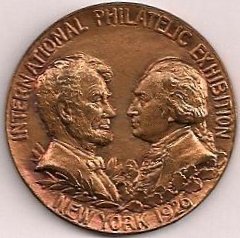 Bob Rightmire is a dedicated researcher. He has been searching for Guttag Bros store cards for a number of years. In answer to his August 2009 inquiry I responded that he faced a lifetime
pursuit. His inquiry in last week’s E-Sylum about a lead mule is evident of the longevity of his search.
Bob Rightmire is a dedicated researcher. He has been searching for Guttag Bros store cards for a number of years. In answer to his August 2009 inquiry I responded that he faced a lifetime
pursuit. His inquiry in last week’s E-Sylum about a lead mule is evident of the longevity of his search.
All Guttag Bros items were modeled by Jonathan M. Swanson. Swanson was not only an experienced medallist he was also president of the New York Numismatic Club, 1923-1926. If Guttag was a member, he could easily commission Swanson to create his firm’s store cards, first in 1926. If not he probably was aware of Swanson’s reputation.
All Guttag Bros medallic items were struck by Medallic Art Company. In my response to his August 2009 inquiry I related the difficulty I faced cataloging Guttag Bros issues for Medallic Art. There were no files of any of their medallic items. I had a couple sample medals so I assigned these 26-37 for their 1926 Philatelic Exhibition Medal -- that’s the one with facing portraits of Lincoln and Washington -- and 27-36 for the firm’s National Coin Week Medal which they had founded for the American Numismatic Association. This is the piece illustrated and Bob’s recent acquisition that he is inquiring about.
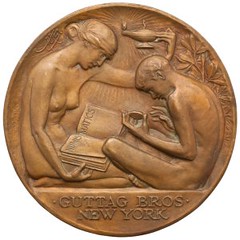 Without any further information I estimated at least five more varieties would be found. Collectors like a lot of varieties, so I foresaw the possibility of Guttag Bros ordering mules and
multiple composition pieces. All Guttag dies were the same diameter so that made muleing easy.
Without any further information I estimated at least five more varieties would be found. Collectors like a lot of varieties, so I foresaw the possibility of Guttag Bros ordering mules and
multiple composition pieces. All Guttag dies were the same diameter so that made muleing easy.
Bob Rightmire deserves a gold star for his persistent digging for the facts in this project. No. Make that a medal, a Guttag Medal!
SWANSON, Jonathan M. (1888-1963) medalist, sculptor, painter, numismatist.
Full name: Jonathan Marmaduke Swanson.
Born Chicago, Illinois, 21 July 1888.
Active member, officer, and most noted as sculptor of presidential portraits New York Numismatic Club series, he was president of this organization 1923-1926. He exhibited these prominent numismatists' portrait medals at the National Academy of Design in New York City: Valentine (1923), Frey (1924), Saltus (1924-W), his own portrait (1927-W), and Blake (1929-W). With the exception of a few of these NYNC presidential medals (1917-23) all of Swanson's medallic work was struck by Whitehead & Hoag until 1923; all afterwards by Medallic Art Company.
Died New York, February 1963.
Signed dies JMS monogram (11 different).
1926 Guttag Brothers Numismatic Allegorical Figures Galvano
(model for rev of 1927 International Philatelic Expo Medal, MAco 26-37 below; and obv of Guttag Bros.
Storecard Medal, 27-36 below) . . . . . . . . . . . . . . . .
Collection: American Numismatic Society
1933 New York Numismatic Club 25th Anniversary Howland
Wood Portrait Galvano . . . . . . . . . . . . . . . . . . . . .
Auctions:. . . . . . . . . . . . . . . . . . . . . . . . PCA 72:602
1926 International Philatelic Exhibition Medal (obv with Washington and Lincoln portraits; rev with Guttag Brothers inscription and logo). . . . . . . . . . . . MAco 26-37,
Baker 730, King 932
Auctions:. . .
CAL 35:2291;
J&J 8:556,
J&J 10:1624-1626;
NAS 22:4217;
PCA 44:654,
PCA 45:659,
PCA 46:903-905,
PCA 46:1169
1927 Guttag Brothers National Coin Week Medal . MAco 27-36- 1 Auctions:. .
CAL 35:816-817;
J&J 8:557-558,
J&J 10:263,
J&J 18:479,
J&J 25:1433;
PCA 46:905,
PCA 46:1169
1927 New York Guttag Brothers Medal . . . . . . MAco 27-36- 2 Auctions:. . . . . .
J&J 13:601,
J&J 27:925;
PCA 59:1626
Illustrated: The Numismatist 39:11 (November 1926) p 619
CAL - Collectors Auctions Limited
J&J - Johnson & Jensen
MAco - Medallic Art Company
NAS - NASCA
PCA - Presidential Coin & Antique
-Editor
To read the earlier E-Sylum articles, see:
QUERY: RESEARCHER SEEKS 1926 GUTTAG BROTHERS TOKEN (http://www.coinbooks.org/esylum_v12n32a12.html)
NOTES FROM E-SYLUM READERS: MARCH 18, 2018 : Query: Guttag Brothers Store Card Information Sought
(http://www.coinbooks.org/v21/esylum_v21n11a10.html)
VOCABULARY TERMS: BULLION COIN AND MEDAL, NCLT
Last week we defined Bullion. This week we define three terms of bullion items. While mankind has coveted ownership of precious metals for centuries, the metal was in jewelry or other forms not easily used in transactions. This resulted in the modern invention of bullion in coin form. Bullion coins have denominations, bullion medals do not. Noncirculating legal tender add somewhat of a commemorative nature with better design images.
Bullion Coin. A numismatic item issued not for monetary purposes but for its metal content. Bullion coins have been struck in precious metals of silver, gold, platinum, palladium and, in a sense, are coined ingots (struck from coining dies on coining presses). Bullion coins always bear a denomination (they would be BULLION MEDALS if they do not) but are not intended to circulate at that denomination. They may be legal tender in the country of their issue; as such they are classed as NONCIRCULATING LEGAL TENDER. In fact, however, the denomination is always at a substantial discount from its precious metal value.
The fineness (purity) and weight of bullion coins are usually identified on the item; as .999 fine (.9167 for U.S. gold eagles) and they usually weigh an exact ounce, an exact fraction of an ounce, or an exact multiple of an ounce for ease of quick valuation. Bullion coins sell near the spot price for their metal on the day of transaction, thus fluctuate in value constantly. Since the purity is guaranteed by the issuer no refinery charge or assaying cost is necessary at any transaction as it would be with normal ingots.
The classic bullion coin is the Maria Theresa Thaler of 1780.
CLASS 01
REFERENCE:
NE22 {1975) COIN WORLD ALMANAC, CHAPTER 15 IN LATER EDITIONS.
Bullion Medal. A medallic item created not for its commemorative, historical, souvenir or art design aspect, but for the precious metal it contains. Obviously, bullion medals bear no denomination, but, like BULLION COINS, each piece is usually marked with its fineness, its weight (usually a multiple or fraction of an exact ounce), and sells at its bullion value – not at a collector value.
An early Example was a Washington Medal, 1976, struck in platinum by Medallic Art Company. In 1980 the United States Mint introduced a series of bullion medals, “America Arts Gold Medals.” Issued
in two weights – full ounce and half ounce – each bore the portrait of a notable American artist. The series continued for four years, but ceased for lack of demand. Buyers of coined bullion items,
it was learned, preferred those with a denomination, in effect bullion coins, despite the fact the denomination had little relationship to the value of the item’s precious metal content. See
ADILLION, a bullion medal of Israel.
CLASS 01
Noncirculating Legal Tender. A coin bearing all characteristics of a circulating coin, but intended to be sold to collectors and the public instead. Usually such a
coin is sold at a premium over the face value and frequently in sets of two or more. The design is often commemorative and in a composition not usual for circulating coin. Such coins in precious
metals are popular. The quantity struck is often small but the size is sometimes larger than typical circulating coin. Bullion coins bearing a denomination fall in this class of mint-struck objects.
Caribbean island countries and third world countries were first to issue these coins, now many countries do. The term is abbreviated NCLT.
CLASS 11.4
Reference:
NE42 {1982} Doty, p 228-229.
To read the earlier E-Sylum article, see:
VOCABULARY TERM: BULLION (http://www.coinbooks.org/v21/esylum_v21n11a13.html)
Looking for the meaning of a numismatic word, or the description of a term? Try the Newman Numismatic Portal's Numismatic Dictionary at: https://nnp.wustl.edu/library/dictionary
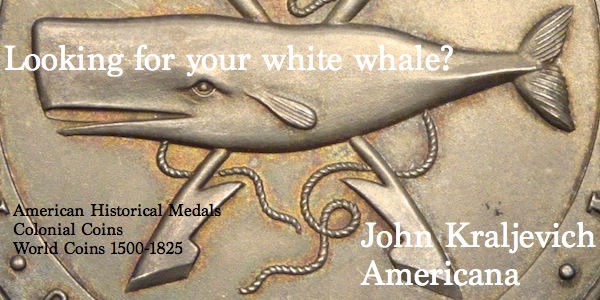
HARRY BENNETT WILBER (1872-1945)
Harry Bennett Wilber (1872-1945), was born on March 6, 1872 at Cambridge Springs, Pennsylvania, son of John Bennett Wilber (1830-), a wealthy lumberman and hardware merchant, and Mary Alice Wilber (1837-).
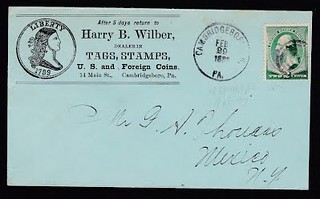 He worked in his father's hardware store as a schoolboy where began collecting coins trading the unusual, old and odd ones for his pay. Typical of schoolboys in the 1880's he traded
tobacco tin tags for stamps, coins, and other tin tags. Later on he began selling them through advertisements in magazines.
He worked in his father's hardware store as a schoolboy where began collecting coins trading the unusual, old and odd ones for his pay. Typical of schoolboys in the 1880's he traded
tobacco tin tags for stamps, coins, and other tin tags. Later on he began selling them through advertisements in magazines.
By 1890, he was established as a printer of philatelic literature. In 1891, he published Dealing in Postage Stamps by Alvah Davison. Also A Directory of the Principal U.S. and Canadian Stamp Dealers. Vol. 4. 4 vols. Philatelic Library. Cambridgeboro, PA: H.B. Wilber & Company, 1891
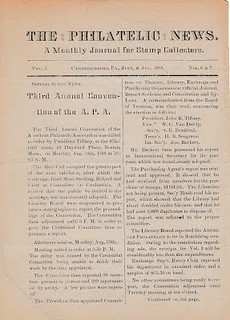
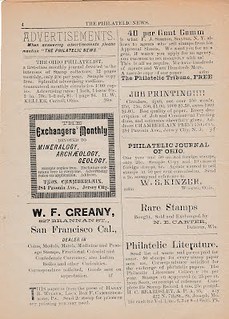
The Philatelic News
On January 25, 1893, he married Mary Stanislaus May (1872-1919) at Jamestown, New York. They had four sons : Harry Russell Wilber (1893-), John Roland Wilber (1896-1987), and Paul Francis Wilber (1898-1979), and Theodore Joseph Daniel Wilber (1908-1989).
By the late 1890's, in addition to his publishing work and dealing in coins, stamps, and curios, he was also the manager of Sayles Opera House, Cambridgeboro, Pennsylvania.
To read the complete article, see:
WILBER, HARRY BENNETT
(https://sites.google.com/a/numismaticmall.com/www/numismaticmall-com/wilber-harry-bennet)
The entire inventory of the Lupia Numismatic Library is for sale. Individual items will be available before the remaining archives are broken up into parcels sold at philatelic auctions in the U. S. and Hong Kong. Check NumismaticMall.com frequently as dozens of new items with estimates will be posted daily until everything is sold.
All inquiries will be given prompt and courteous attention. Write to: john@numismaticmall.com .
HARVEY STACK'S NUMISMATIC FAMILY, PART 14
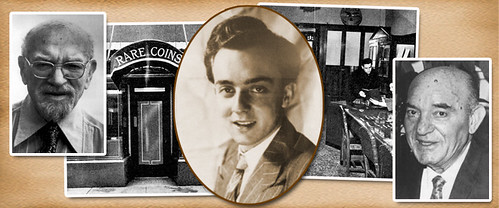
By early February 1953, we were preparing to move our store from 46th Street to our current location on West 57th Street. This included moving our inventory, including the cases loaded with coins that were set up behind our counters and down a hallway leading to the back of the shop. The coins were housed small 2x2 boxes in trays so they could be examined easily. Each tray was 22 X 18 inches in size. Some of the world coins were initially sent to Coin Galleries, the balance was to go to our new store.
Moving these cabinets was hard. First, we first had to find a lift-back truck, with a gate that came down so each cabinet could be put on a dolly, loaded on the truck and then driven to the new location. The thought that the cabinets might roll or shift during the move made us all cringe a bit.
Measurements were carefully calculated to place the cases in order on their new wall space. When the moving teams were in place, Morton dispatched each cabinet in order. I supervised the truck loading and unloading, and I traveled "shot gun," riding in the truck to insure safe delivery. Uncle Joe, (who later liked to be called "J.B.") directed the arrangement of the cabinets at the new location at 123. Each move was slow and careful, but it all got done. New showcases and chairs had already been delivered and were ready to be placed, so in relatively short order (over a three-day weekend) Stack's would be back in business. When I remember it now, especially at my age, it still amazes me that we could get it done.
Our vast stock of United States coins, especially the silver and copper coins, was in drawers about 10 inches wide by 18 inches deep. Each cabinet had six of these draws across and 8 high. Within each drawer were 2x2 coin envelopes each holding one coin. Each section was heavy, especially when there were half dollar and dollar coins in the envelopes. We made covers for each tray, strapped them closed, numbered them, and moved them one by one on dollies. Taking out each drawer and wrapping it for transport was done by our staff and myself. In those days I was learning more about moving than numismatics.
In early April we were ready to do business at 123 West 57th Street. Over the move we had managed to keep one location open, answer phone calls, wait on customers, fill orders and catalog for a forthcoming auction or two. For several weeks during that time we spent seven days a week in the shop, but it was worth it to stay in operation. During that time, my uncle "J.B" also traveled to see clients and bought and sold as he went from place to place. He even went to Lawrence, Massachusetts. to appraise an estate and make an offer, a story I will tell later.
The coin business was very active. We maintained our usual schedule of auctions and produced price lists. We were able to host the Metropolitan New York convention auction, the New England Numismatic auction and other sales.
Numismatic history was also being made. King Farouk of Egypt, an avid collector of coins and other things, abdicated his throne in 1952. In early 1953 it was announced that his massive numismatic collection would be sold in Cairo in 1954. We heard that the U.S. coins would be sold in group lots, cataloged by Baldwin of London, and sold by Sotheby's in Egypt. There was a general feeling that bargains might be found in these group lots. Dealers were informed that large deposits would have to be made in dollars before they could bid and that invoices would have to be paid after each session. They started to accumulate funds to attend the sale, and Stack’s also began setting funds aside to attend.
But, things do not always go as expected, and as fate would have it, other events would come about that would take precedence over the Farouk offerings.
To read the complete article, see:
Harvey Stack Remembers: Growing up in a Numismatic Family, Part 14
(http://www.stacksbowers.com/News/Pages/Blogs.aspx?ArticleID=2907)
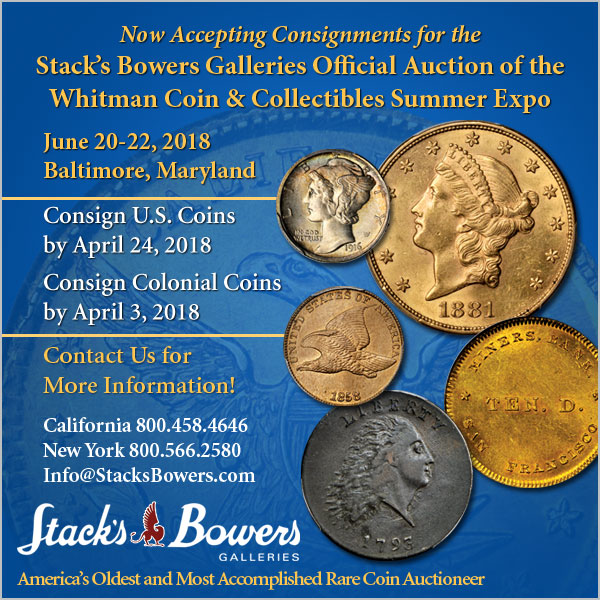
BRITISH INDIA GEORGE VI QUARTER ANNA VARIETIES

I had recently purchased a 1938 Calcutta Mint Quarter Anna Proof, which looked different to me. So, I compared it to my Proof Restrike example, and found a remarkable difference and that is what has triggered this research. After going through innumerous examples of Type I Quarter Annas (of 1938 and 1939) for the next 10-months or so, I have come to the conclusion that there is a noteworthy difference between Obverse A (Pridmore Type I) of 1938 Quarter Anna and that of 1939. After going through this article, collectors should be able to easily identify just by looking at the Type I Obverse of a Quarter Anna (of 1938 and 1939) if it is a 1938 or a 1939 as it will become easily distinguishable.
1938 Obverse - Long Trefoils in Crown
Trefoils are reaching outside/over the line below the pearls of the crown and almost touching the pearls above. Let's call this Obverse - Type I (a)
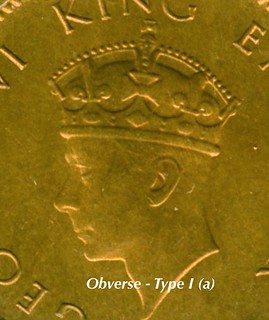
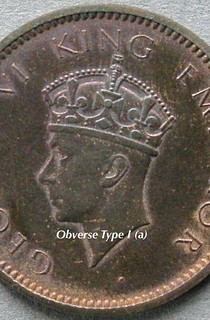
LEFT: 1938 Bombay Quarter Anna Obverse Type I (a) Business Strike
RIGHT: 1938 Calcutta Quarter Anna Obverse Type I (a) Original Proof
1939 Obverse - Long Trefoils in Crown
Trefoils are NOT reaching outside/over the line below the pearls of the crown and therefore not touching the pearls above. Let's call this Obverse - Type I (b)

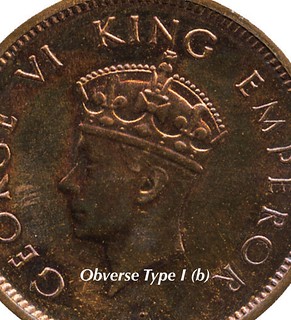
LEFT: 1939 India Bombay Quarter Anna Obverse Type I (b) Business Strike
RIGHT: 1939 India Bombay Quarter Anna Obverse Type I (b) Original Proof
In my opinion, all 1938 Quarter Annas have Obverse - Type I (a) and 1939 (Type I) Quarter Annas have Obverse - Type I (b). However, business strike examples with intermixed Obverse(s), although not encountered by this author, is a definite possibility, but those should be considered mules and should deservedly attract collectors' attention.
Also to be noted is that there are further minor variances in trefoil thickness/size, tip shape, and font thickness. But these variances, from my standpoint, are rather insignificant and more specific to the individual years. Like for the year 1938 Obverse Type I (a), there are minute differences, and for the 1939 Obverse Type I (b) there are other minute differences, but those are not necessarily present in the 1938 Obverse and vice-versa. Regardless, once the understanding of trefoils "almost touching the pearls" vs "not touching the pearls" becomes clear, then 1938 and Type I 1939 Quarter Anna Obverse(s) can be easily differentiated.
Interestingly enough, all proof examples of 1938 Quarter Anna that have come at auctions since the year 2000 have the Obverse Type I (b) and are classified as later restrike proofs and that is quite logical. Also, another giveaway was that these restrike examples have all been lacquered as that was a general practice of the mint at the time restriking took place[1].
Furthermore, even the most comprehensive collections put together (like Diana, David Fore (took 50 years in assembling), Arielle, and examples offered by Heritage, Stacks, Goldberg, Steve Album) only had the later restrike examples of the 1938 Quarter Anna Proof. One can find this easily by searching the past auction archives. There is not a single 1938 Quarter Anna Proof with the Obverse Type I (a).
On the other hand, the Fore sale had the Original Proofs of 1939 Quarter Anna in both Type I and Type II Obverse. The Type I example had the Obverse Type I (b), which should be the case as all Type I business strikes of 1939 Quarter Anna have the Obverse Type I (b).
Consequently, it would be safe to assume that all 1938 Quarter Anna Original Proofs should have the Obverse Type I (a) - trefoils almost touching the pearls and that should be taken as a significant indicator of a true 1938 striking.
Acknowledgements:
1. The Uniform Coinage of India 1835 to 1947 A Catalogue and Pricelist - By Paul Stevens & Randy Weir
Image References:
1938 - Bombay Quarter Anna - Business Strike - Obverse Type I (a) (https://i.ebayimg.com/images/g/w4YAAOSwhpZaOu-s/s-l1600.jpg)
1938 - Calcutta Quarter Anna - Original Proof - Obverse Type I (a) (https://www.royalcollection.org.uk/collection/search#/5/collection/445054/india-george-vi-proof-14-anna-1938)
1939 - Bombay Quarter Anna - Business Strike - Obverse Type I (b) (https://en.numista.com/catalogue/photos/inde_britannique/g1857.jpg)
1939 - Bombay Quarter Anna - Original Proof - Obverse Type I (b) (https://www.numisbids.com/n.php?p=lot&sid=451&lot=251)
MINNEAPOLIS MARCH 2018 YOUNG NUMISMATIST EVENT
The Northwest Coin Club of Minneapolis held its 84th Annual Money Show on March 16-18, 2018. In addition to serving dealers and collectors, the club makes a special effort to promote numismatics among youth.
On Saturday, March 17, club president George Ross presented a Boy Scout merit badge class to 24 registered scouts. In this photo, one of the scouts is interviewed by reporter Lou Reguse from local TV station KARE 11.
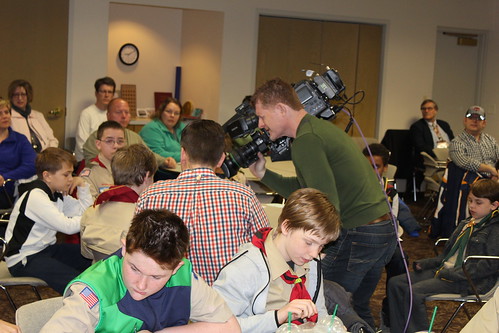
On Sunday, March 18, Ron Schmidt conducted an auction for youth 7 to 14 years of age. Kids are given $200 in credit to spend at the auction. About a dozen club members assisted at the auction moving lots, spotting bidders and recording bids. One of the helpers is a young woman who previously participated in the sale but has ‘aged out.” About 70 kids and their parents attended.
In this photo kids are looking at the auction lots prior to the sale.
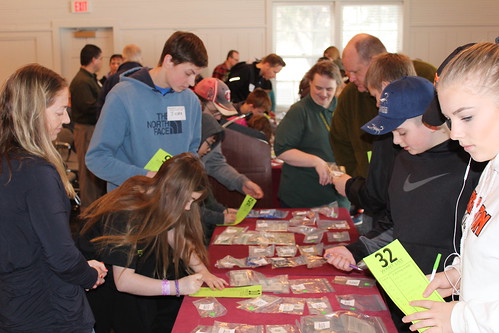
In this photo auctioneer Schmidt explains the rules to the crowd.
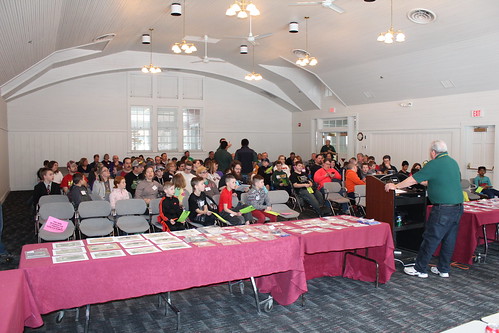
Another favorite for the public was a demonstration of hammered coinage conducted by Bart Saxton and Dawson Lewis of the Society For Creative Anachronism. Saxton punched a special commemorative die for the show and handed out free examples to the public.
In this photo, Saxton is one the left and Lewis on the right.
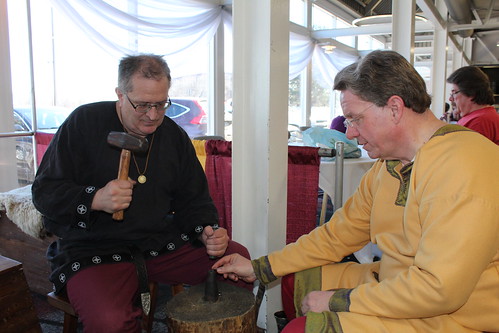
The Society for Creative Anachronism is an international organization dedicated to researching and re-creating the arts and skills of pre-17th-century Europe. Our “Known World” consists of 20 kingdoms, with over 30,000 members residing in countries around the world. Members, dressed in clothing of the Middle Ages and Renaissance, attend events which feature tournaments, royal courts, feasts, dancing, various classes & workshops, and more.
For more information on the Society For Creative Anachronism, see:
http://www.sca.org/
To read the earlier E-Sylum article, see:
WAYNE'S NUMISMATIC DIARY: MARCH 3, 2018 (http://www.coinbooks.org/v21/esylum_v21n11a24.html)
THE A & A SAINTS COLLECTION OF DOUBLE EAGLES
Finest Known 1932 “Saint” In eBay Auction Of Outstanding Double Eagles Set
One of the all-time finest collections of Saint-Gaudens Double Eagle gold coins listed in the PCGS Set Registry®, the A&A Saints Collection, will go on auction on eBay starting at 6 pm Pacific time March 29 through April 8, 2018. The set includes the finest known 1932 “Saint,” graded PCGS Gold Shield MS66+ and formerly in the famous collections of Dr. Steven Duckor and David Akers.
The seller will donate a portion of the auction proceeds to combat counterfeits in the numismatic marketplace.
In addition to the 1932 Saint, other highlights of the A&A Saints Collection include the 1907 High Relief Wire Edge, graded PCGS Gold Shield MS67, ex. Harry Bass; 1909-D, PCGS Gold Shield MS67 CAC tied for finest known, ex. Louis E. Eliasberg, Sr. and Duckor collections; 1914, PCGS Gold Shield MS66+ CAC finest known, ex. Duckor; and 1924 PCGS Gold Shield MS68 finest known.
Given the collection’s overall outstanding grade point average, and the historic pedigree of many of the individual coins, Stuppler estimates its value to be more than $7 million. The entire collection can be viewed at www.SaintSet.com.
After the sale is completed, three percent of the sale proceeds will go to nonprofit organizations including the Children’s Hospital of Los Angeles, The ALS Association, and the Anti-Counterfeiting Education Foundation.
Nicknamed “Saints” and placed into circulation from 1907 to 1932, the U.S. $20 denomination Double Eagle gold pieces were exquisitely designed more than a century ago by acclaimed sculptor Augustus Saint-Gaudens at the request of President Teddy Roosevelt.
For more information and to bid on the collection, visit: www.SaintSet.com or call 888-454- 0444.
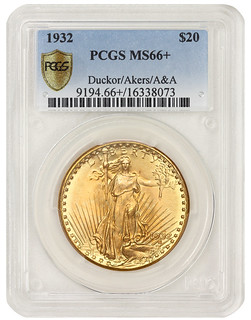
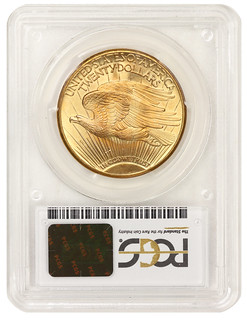
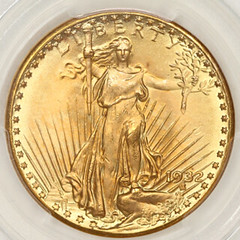

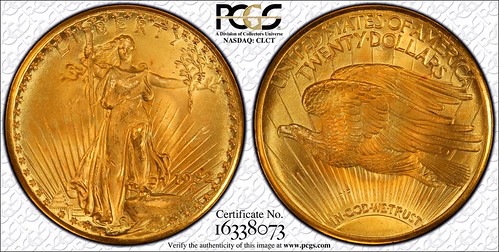
1932 Double Eagle certificate
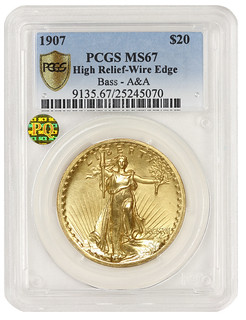
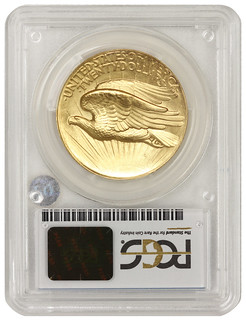
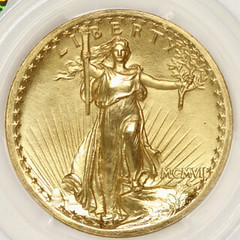
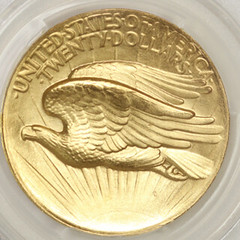

1907 $20 High Relief-Wire Edge certificate
To view the complete collection, see:
A & A Saints Collection - 5th
(https://www.pcgs.com/SetRegistry/gold/20-gold-major-sets/st-gaudens-20-gold-basic-set-circulation-strikes-1907-1932/alltimeset/125030)
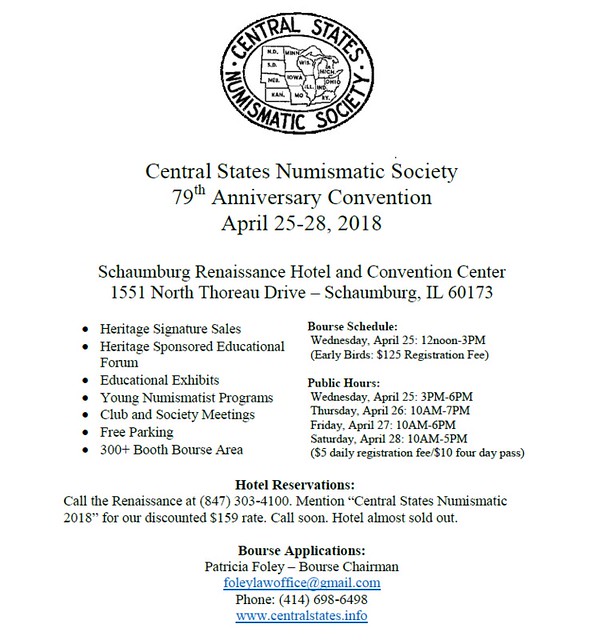
NUMISMATIC NUGGETS: MARCH 25, 2018
Selinos Tetradrachm
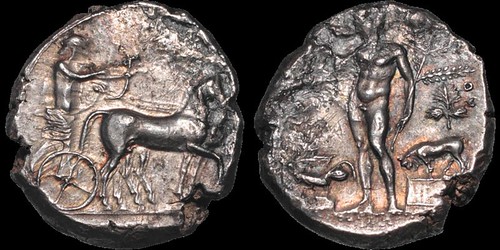
SICILY. Selinos. Circa 455-409 B.C. AR tetradrachm. 16.97 gm. 25 mm. Artemis, holding reins, driving quadriga right; beside her, Apollo standing right, drawing bow; barley grain in exergue / The young river god Selinos standing facing, head left, cradling palm frond and holding phiale over altar to left; before altar, cock standing left; to right, selinon (wild celery) leaf above bull standing left on basis. Schwabacher 30. HGC 2, 1221. SNG ANS 698. Jameson 720. Near Extremely Fine; beautiful style dies, well struck. Lightly toned with iridescence; traces of horn silver around part of rim. Exceptionally attractive example of this beautiful and difficult issue. Rare.
Selinos was founded about 628 BC, the westernmost Greek colony on Sicily, and was named for the wild celery that flourished there. This magnificent tetradrachm was struck at the height of Selinos' power and wealth, within a few decades before its destruction in 409 BC by an army of combined forces from Segesta and Carthage. A similar type was chosen by Charles Seltman for his famous book "Masterpieces of Greek Coins."
Allan Davisson adds:
This is a beautiful piece of art. In a strange sort of way the horn silver adds an intriguing element reflecting the passage of twenty-four centuries since it was crafted. (It also makes this piece of fine art more accessible to those with more limited financial means.)
To read the complete lot description, see:
E-Auction 24 Lot 12 (https://davcoin.com/lot/e-auction-24-lot-12)
North Africa, Sabratha AE Unit
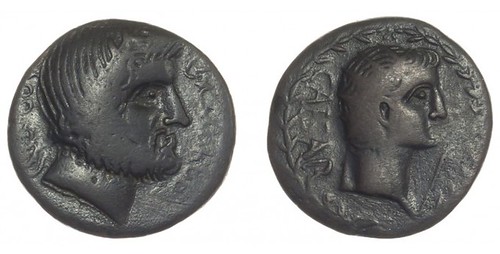
North Africa, Sabratha (Time of Tiberius, 14-37 AD)
AE Unit,
Obverse: Radiate head of Divus Augustus facing right, CEASAR all within laurel wreath.
Reverse: Bearded head (Baal-Melqart) facing right.
Rare. Pleasing brown patina. Good Very Fine.
14.45gm.
RPC 816.2.
To read the complete lot description, see:
North Africa, Sabratha, AE Unit (https://www.baldwin.co.uk/north-africa-sabratha-ae-unit.html)
1968 Illinois Sesquicentennial Bronze Medal
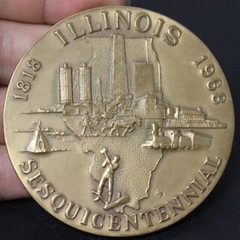

To read the complete lot description, see:
Lot 51624: A 1968 Illinois Sesquicentennial Bronze Medal (https://www.invaluable.com/auction-lot/-1-c-B5946B795B)
SELECTONS FROM STACK'S BOWERS MARCH 26, 2018 SALE
Lot 5009 1882 Rock Island Arsenal Workman's Pass
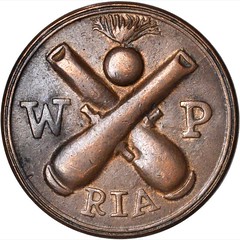
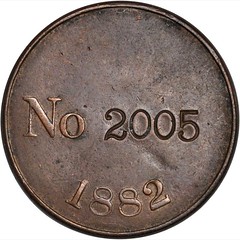
To read the complete lot description, see:
1882 Rock Island, Illinois Arsenal Workman's Pass No. 2005. Bronze. 41 mm
(https://auctions.stacksbowers.com/lots/view/3-9HZI6)
Lot 5144: 1833 Liberia American Colonization Society Cent
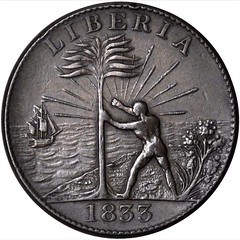
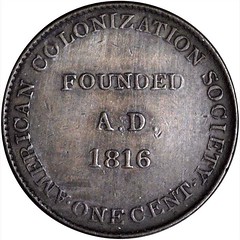
Liberia. Lot of (2) 1833 Token Cents. EF-40.
Included are: KM-Tn1, CH-4, Large Ship; and KM-Tn2, CH-1, Small Ship.
To read the complete lot description, see:
Liberia. Lot of (2) 1833 Token Cents. (https://auctions.stacksbowers.com/lots/view/3-9I2WY)
Lot 5145: Bache Coast Survey Medal

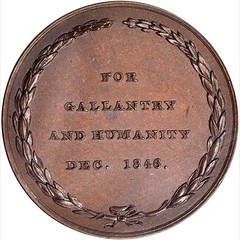
"1846" (1861) Bache Coast Survey Medal. Bronze. 34 mm. By Franklin Peale. Julian LS-4. MS-65 BN (NGC).
These were struck to commemorate the deaths of Lieutenant George M. Bache and 10 of his men who were swept overboard from the brig Washington in September 1846 during a violent hurricane while doing coastal surveys off North Carolina, an area of the U.S. coast that has claimed uncountable lives in the past few centuries.
To read the complete lot description, see:
"1846" (1861) Bache Coast Survey Medal. Bronze. 34 mm. By Franklin Peale. Julian LS-4.
(https://auctions.stacksbowers.com/lots/view/3-9HX8K)
Lot 5289: Unidentified S.T.V. Token

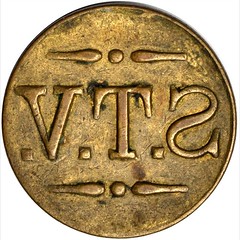
An enigmatic type, the incuse inscription S.T.V. on the obverse is of uncertain translation, and is repeated on the reverse raised and retrograde. Remarkably similar to the rare unidentified S.T.V.6 inscription of the Schenkman-listed piece. Indeed, it is not even known with certainty if this is a sutler token, but it seems of an appropriate style and fabric for a token of that period. Unlisted in TokenCatalog.com.
To read the complete lot description, see:
Unidentified. Similar to Schenkman UI-P-B. Brass. 21.8 mm. (https://auctions.stacksbowers.com/lots/view/3-9HXHK)
Lot 5297: Indian Territory Osage Traders Token
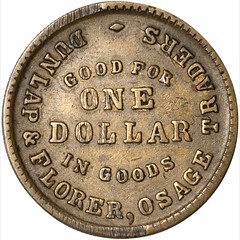

To read the complete lot description, see:
Indian Territory--Pawhuska. Undated Dunlop & Florer Osage Traders. $1.00. Brass. 22 mm. VF-30.
(https://auctions.stacksbowers.com/lots/view/3-9HY74)
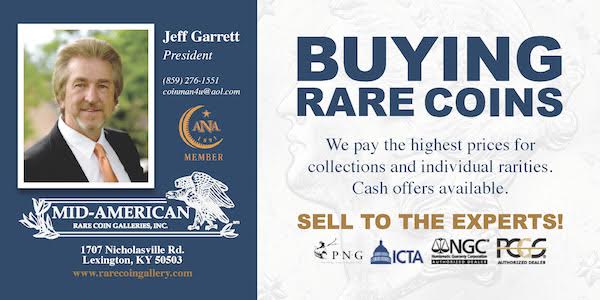
WAYNE'S NUMISMATIC DIARY: MARCH 25, 2018
Living in Northern Virginia makes it easy to get to the Whitman Coin Expos in Baltimore. On Thursday March 22, 2018 I had some meetings to attend at work but was able to take off early and arrive in Baltimore around 2:30pm. I checked into a hotel, charged my phone, then headed over to the convention center.While filling out my registration card Charles Morgan of CoinWeek stopped by and we had a nice chat. He would be busy the rest of the day filming videos. Look for the latest at https://coinweek.com/ .
William and Charles Barber
My first stop on the bourse floor was the Barber Coin Collectors' Society table where I met up with BCCS President John Frost. He told me about a project he'd been working on for some time.
He'd made contact with descendants of father and son Mint Engravers William and Charles Barber. The Spring 2018 issue of the Journal of the Barber Coin Collectors' Society has the
first of a series of articles John has written based on material in the possession of the family. A number of items were on display in an exhibit case.
Stay tuned for more information - a larger public exhibit is in the works for later this year. I signed up as a member, and you can, too. For more information on the BCCS, see: http://www.barbercoins.org/ .
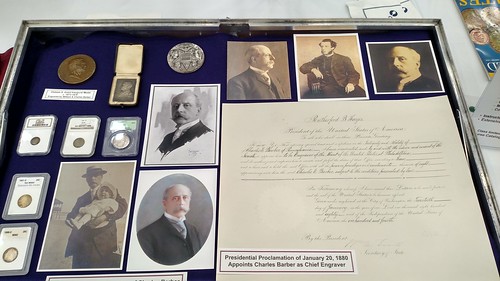

Carl Feldman, John Frost, Joe Casazza
Whitman Booth
My next stop was the nearby Whitman Publications booth, where the big event of the show was the release of the newest edition of the Red Book (A Guide Book of United States Coins). For those
who haven't heard, longtime Red Book editor Ken Bressett has become the Editor Emeritus, making way for Jeff Garrett to take a larger role.
Ken, Dave Bowers and Jeff were scheduled to sign books for the public, but the week's snowstorms threw a monkey wrench into those plans. With flights out of New Hampshire cancelled and Amtrak shut down, Dave Bowers had to bow out. Ken Bressett had similar problems trying to travel from his home in Colorado Springs. Overall show attendance (both dealer and public) was down a bit because of these difficulties.
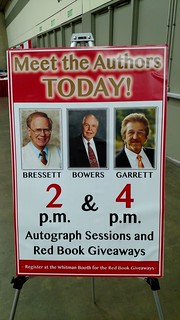
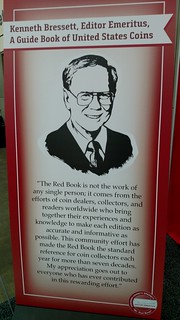
I took the opportunity to purchase a hardbound copy of the new Red Book for use later in the evening.
Mike Markowitz
While waiting at the checkout counter I ran into CoinWeek ancient coins columnist Mike Markowitz. He proudly showed me a great new acquisition he'd just purchased from Harlan Berk.
It's a gold solidus of Constantine VI and Irene. Look for more information in one of his upcoming articles. He shared this today, from Berk's web site:
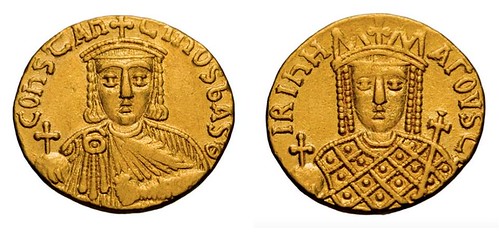
"Constantine VI and Irene; 780-797 AD. Constantinople, c. 792-7 AD. Solidus, 4.46g. Berk-235, DO-3, Sear-1594. Obv: Bust of Irene facing, wearing crown and loros, and holding cross on globe and cruciform scepter. Rx: Bust of Constantine VI facing, beardless, wearing crown and chlamys, and holding cross on globe and akakia."
Mike adds:
By way of explanation, the loros was a heavily embroidered and jeweled wrap that was one of the symbolic imperial robes. The chlamys was a simpler garment, usually depicted with pleats. The akakia was a hand-held metal tube filled with ashes, that was supposed to remind the emperor of his mortality.
After Constantine was deposed and blinded, Irene put her portrait on BOTH sides of her gold coinage ("Heads I win, tails you lose"). That is one of the coins that every serious Byzantine collector longs to possess. I got mine from Waddell some years ago.
For a fuller story, see: https://en.wikipedia.org/wiki/Irene_of_Athens .
Stack's Bowers Table
Earlier in the week I'd been in touch with John Herzog of New York, who told me some of his U.. treasury bonds would be on exhibit at the Stack's Bowers table. So I stopped by to have a look.
Impressive. I was especially intrigued by the Cherokee Nation bond.
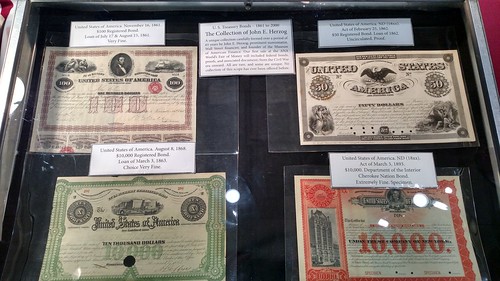
Also on display were highlights from the Joel Anderson paper money collection. Wow! Sorry for the quality of my photos - it was hard to avoid glare from overhead lights.
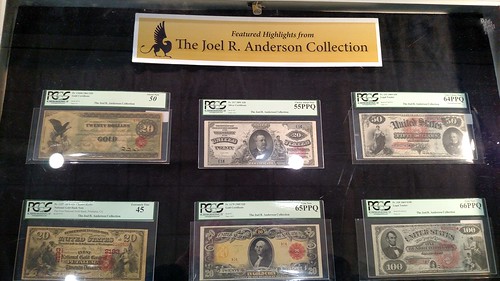
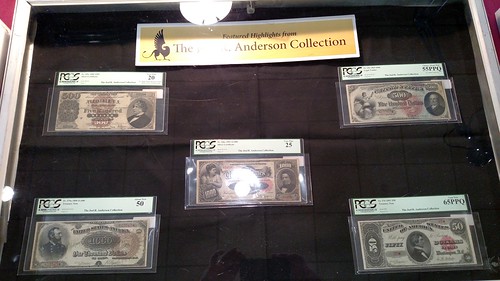

The notes sold quite strongly, bringing some amazing prices. For results of the first sale, see:
https://auctions.stacksbowers.com/auctions/3-9HU32?jump_to_lot=1016
Thanks to Martin Kaplan for the link.
Bource Floor Wanderings
I flitted about the bourse floor until almost 6pm. From a distance I saw Julian Leidman and Wayne Herndon with customers at their tables. I didn't interrupt, knowing I would have a chance to
speak with them at dinner.
I came across Chris Neuzil seated at John Kraljevich's table talking to JK and Erik Goldstein of Colonial Williamsburg. I pulled up a chair and joined the conversation. Topics included Erik's January 2018 Numismatist article on the Continental Dollars, Chris' manuscript on medals of the War of 1812, technology changes, "kids these days" and the concept of "sitting naked in a bathtub filled with Pine Tree Shillings" ala a colonial Scrooge McDuck. I can neither confirm nor deny that sips of corn squeezin's were involved.
Others I spoke to at least briefly were Tony Terranova (at the table adjacent to JK's) and Ian Russell of Great Collections. I took a few minutes to call home to my wife, then trekked across the street to the Pratt Street Ale House.
Nummis Nova March 2018 Baltimore Dinner
My Numismatic Diary articles often feature the people and events at the monthly meetings of my Northern Virginia numismatic social group Nummis Nova. And often E-Sylum readers tell me how much they enjoy the write-ups and how they'd love an opportunity to join us sometime. Well, to make this easier, a couple years ago we started holding a dinner at the March Whitman Coin Expo in Baltimore. This year we met across the street from the Baltimore convention center in an upstairs room at the Pratt Street Ale House.
Due to a bout of the flu, our host Eric Schena was unable to attend. Many thanks to Eric for his work reserving the venue and making the arrangements. Get well soon! The same goes for Joe Esposito, who was also out sick. And due to the snowstorm the previous day, Roger Burdette bowed out after taking a fall on slick pavement.
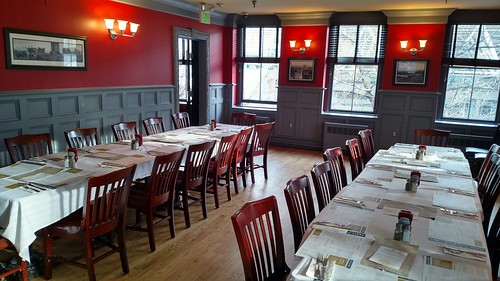
I arrived early to handle hosting duties for Eric. The restaurant had everything under control. The room was already set up, and I began texting people to come early if they wanted.
In addition to myself, the regular Nummis Nova members attending were Chris Neuzil, Dave Schenkman, Julian Leidman, and Wayne Herndon.
Mike Merrill is a coin dealer from Maryland. Ben Swanson is a token collector from Baltimore; he and Mike were guests of Dave Schenkman. Coming in from the Pittsburgh area were my guests ANA Governor Tom Uram, his brother Jim, and Ray Oshinski.
Rounding out the list of attendees were Charlie Davis, Dennis Tucker, Jeff Garrett, John Dannreuther, Len Augsburger, Mike Markowitz, Neil Musante and Steve Roach.
We didn't do any formal introductions. People just arrived and joined the conversation. Topics in my vicinity included the show and people's travel difficulties, The E-Sylum and the new ANA Edition, families, John Dannreuther's new book and new house, the Northwest Territorial Mint bankruptcy, the May PAN show, and the Newman Numismatic Portal. A number of folks asked about Joe Levine, who has been recovering following hospitalization and is doing well.
Here are other photos taken during the evening by myself and others.
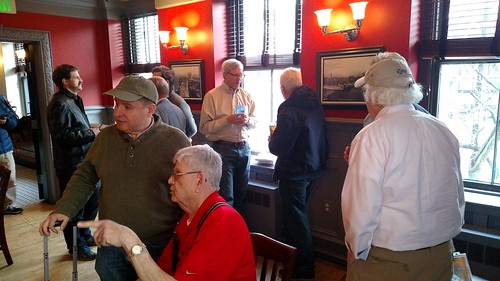
Mingling
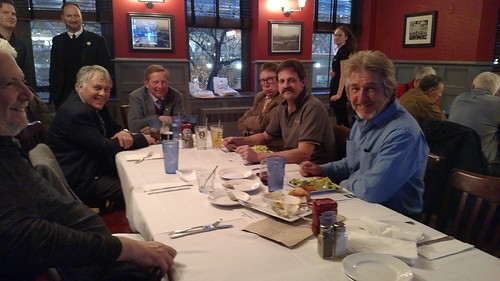
Seated, clockwise from left: John Dannreuther, Ray Oshinski, Tom and Jim Uram, Wayne Herndon and Jeff Garrett. Standing in back: Steve Roach, Dennis Tucker
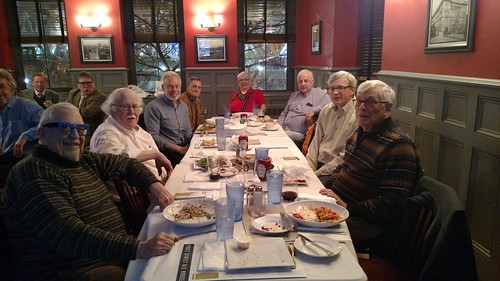
Clockwise from left: Ben Swanson, Charlie Davis, Chris Neuzil, Mike Merrill, Julian Leidman, Mike Markowitz, Len Augsburger and Dave Schenkman.
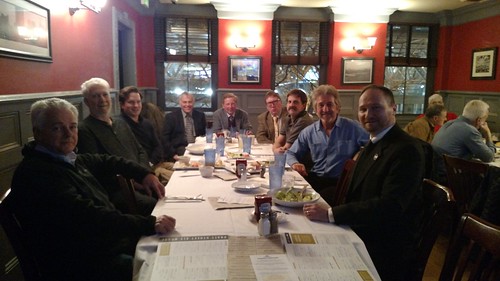
Clockwise from left: Neil Musante, John Dannreuther, Steve Roach, Ray Oshinski, Tom and Jim Uram, Wayne Herndon, Jeff Garrett and Dennis Tucker.
As a record of the evening I passed around the new Red Book for everyone's signature. I plan to donate it to the 2018 Numismatic Bibliomania Society fundraising auction.
People are what make this hobby one of the best there is. I greatly enjoy meeting up with all the friends I've gotten to know in numismatics over the years. The evening was quite a memorable one. Thanks to all who were able to attend this year.
DENNIS TUCKER'S MARCH 2018 BALTIMORE BLOG
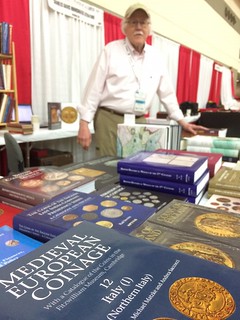
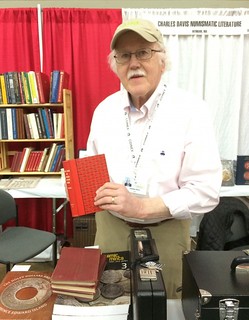
Charlie Davis at his table
A visit with bookseller Charles Davis to browse his selection of numismatic literature is always a highlight of any big coin show. Stop by booth 1062 and be prepared to be wowed by the depth and breadth of beautifully illustrated and well-researched books in our hobby. Charlie is a walking encyclopedia himself, so the conversations at his table are always interesting. I picked up a couple additions for my home library, and Charlie showed me some old Red Books with unusual features.
I enjoyed meeting and chatting with Byron Weston, one of the coauthors of the new book Contemporary Counterfeit Halfpenny and Farthing Families, a nicely illustrated and laid-out presentation of a rich historical subject. Published by the Colonial Coin Collectors Club (C4), the volume is printed on demand—a good use of modern technology for specialized publishing.
An important meeting with ancient-coin specialist Harlan J. Berk firmed up our plans to publish a second edition of his influential book 100 Greatest Ancient Coins. It was a pleasure to spend nearly an hour in far-ranging numismatic conversation with Harlan. After many, many years dealing in every aspect of the hobby, he has more stories than the old Sears Tower (a four-minute walk from his famous storefront in the heart of Chicago’s financial district). We’re excited to be updating his popular book to a new edition this year.
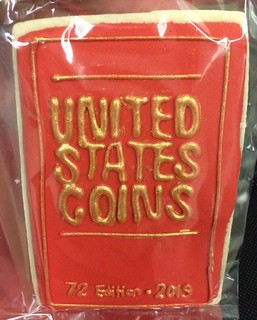
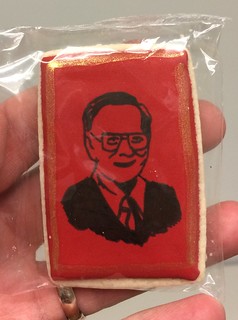
Red Book Cookies!
Back at the Whitman Publishing booth, I met up with Jeff Garrett, past president of the American Numismatic Association and longtime professional coin dealer, who this year has been named senior editor of the Guide Book of United States Coins. Kenneth Bressett is semi-retiring to the role of editor emeritus, with Q. David Bowers continuing in his position as research editor.
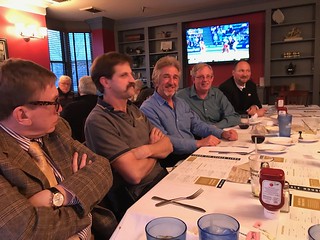
Nummis Nova Dinner: Jim Uram, Wayne Herndon, Jeff Garrett, Wayne Homren, Dennis Tucker
To read the complete article, see:
The Dentuck Balto blog: Thursday, March 22, 2018
(http://news.coinupdate.com/the-dentuck-balto-blog-thursday-march-22-2018/)
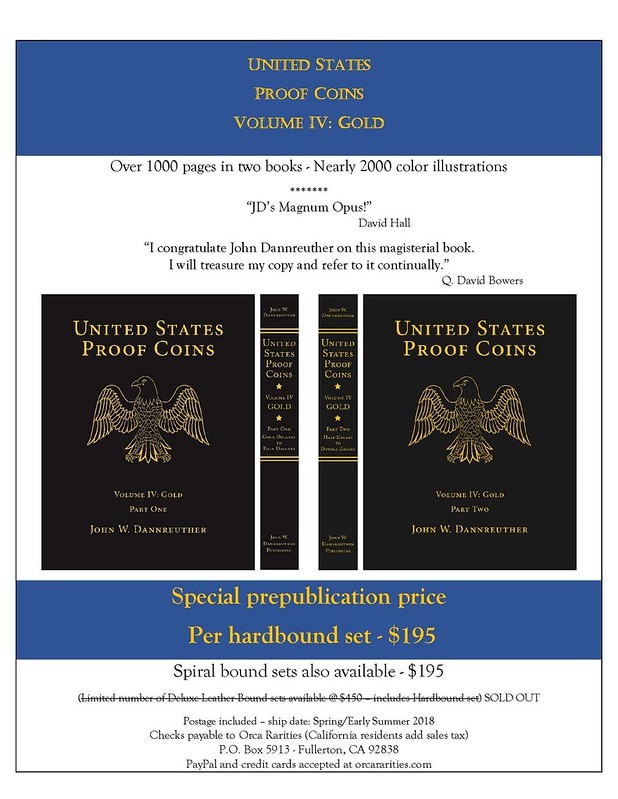
SIGNIFICANT ROMAN COIN FIND IN NORFOLK
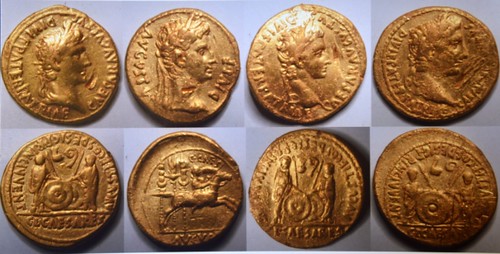
It could be a story line straight out of the hit television series Detectorists.
But instead of Mackenzie Crook and Toby Jones in the leading roles, the stars of this show are Norwich residents Damon Pye and his wife Denise.
The couple recently made a significant Roman coin find on a farm in Norfolk - and what’s even more exciting is that further treasures could still lie buried at their top secret site.
The total hoard uncovered so far includes 52 Roman copper and brass coins, six gold aurei of Augustus coins and a gold quarter stater which is Iceni.
The gold coins date back to between 4BC and 7AD.
Mr Pye, vice chair of the Norwich Detectors Club, said they had made the discovery over the period of a month on a farm within 15 miles of Norwich.
He said: “Roman gold coins are extremely rare and only a handful of finds have been made in East Anglia so to get six is quite something.”
To read the complete article, see:
Norwich couple unearth valuable Roman coin hoard on Norfolk farm
(http://www.edp24.co.uk/news/roman-coin-find-on-norfolk-farm-1-5444888)
NETHERLANDS WORKERS UNCOVER COIN HOARD
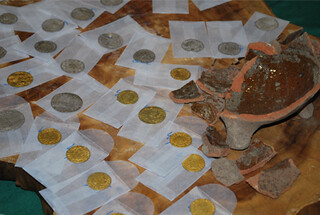 Two construction utility workers doing excavation work to lay water pipes in Hoef and Haag, Netherlands, dug up a medieval cooking pot that contained 12 gold and 462 silver coins, thought
to date back to the 1400's.
Two construction utility workers doing excavation work to lay water pipes in Hoef and Haag, Netherlands, dug up a medieval cooking pot that contained 12 gold and 462 silver coins, thought
to date back to the 1400's.
The men were doing work for Oasen NV, a water distribution utility company, which is building the water distribution network for a new village near the city of Hagestein that will eventually house 21,000 people.
When they made a narrow pipe slot with a mini-excavator last August, they dug up an red glazed earthenware cooking pot filled with gold and silver coins from the fifteenth century. "It literally and figuratively rained coins," according to the company's press release posted in earlier this month.
The pot seemed to have been wrapped in fabric, perhaps to protect the stash. Water must have made its way into the pot because some of the coins had stuck together in a greenish lump.
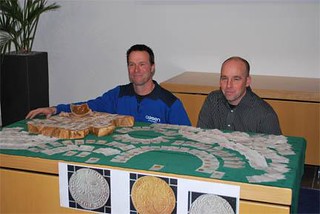 Most of the coins seem to date back to 1470 to the 1480's. They feature engravings of King Henry VI of England (who ruled from 1422 to 1461, and then again from 1470 to 1471), Bishop
Utrecht David of Burgundy (served from 1456 to 1496) and Pope Paul II (appointed in 1464.) The gold Henry II is an especially rare coin.
Most of the coins seem to date back to 1470 to the 1480's. They feature engravings of King Henry VI of England (who ruled from 1422 to 1461, and then again from 1470 to 1471), Bishop
Utrecht David of Burgundy (served from 1456 to 1496) and Pope Paul II (appointed in 1464.) The gold Henry II is an especially rare coin.
De Boer said this time in history was notable because it was after the famous siege of Hagestein in 1405. "A time in which we hitherto hung in the dark for the history of the destroyed city of Hagestein."
"In this sense we have now received a 'pot full of stories' and such a random find that makes you very happy as an archaeologist."
To read the complete article, see:
POT OF GOLD FINALLY FOUND - BY CONSTRUCTION WORKERS
(https://www.constructionequipment.com/pot-gold-finally-found-construction-workers)
CHINA'S "L. GIORGI" PATTERN TEN CASH COIN
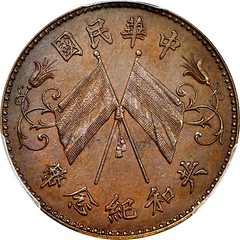
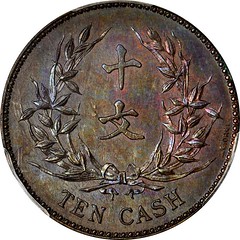
This week’s highlight from the Q. David Bowers/R.B. White collection of Chinese Copper coins is Lot 40299, an incredible pattern 10 Cash, undated (ca. 1914) and signed by the prolific die engraver and head of the Tientsin mint, Luigi Giorgi. As head of the mint from 1910 to 1920 he was tasked with preparing and presenting numerous designs such as the standard Yuan Shih-kai “Fat Man” Dollars and its subsidiaries, including Cash coinage.
The obverse features a somewhat familiar design with crossed flags flanked by curled flowers and vines with Chinese inscription above as “????” (Zhonghuá mínguó [Republic of China]) and below “??????” (Gòng hé kou jìniàn bì [Commemorative coin of the Republic]). What differentiates this design from others is that the crossed flags are national flags rather than the national and Kuomintang flags. The reverse features a simplistic design displaying a wreath containing the Chinese inscription “??” (Shí wén [Ten Wen {Cash}]) with the English inscription “Ten Cash” below.
It would seem that these short-lived denominations never saw mass production, as even the regular circulation issues are quite scarce.
Even though Yuan Shih-kai was disliked by most of the country, the coinage issued under his regime was quite popular, especially the silver issues. They saw mass production and wide circulation up to ten years after his demise on June 4, 1916. Some of the provincial mints up through the warlord period continued producing silver issues. The Anking mint went so far as to debase them to a dismal .560 fine silver.
The outstanding work that Giorgi created while in the employ of the Tientsin mint is a testament to his expertise and artistic style. Not only did he create numerous patterns destined for mass production and wide use in early years of the Republic, but he was also responsible for creating the last of the Manchu dragon dollars.
To read the complete lot description, see:
CHINA. Pattern 10 Cash, ND (1914). Signed: "L. GIORGI". Tientsin Mint.
(https://auctions.stacksbowers.com/lots/view/3-9MPLL)
To read the complete article, see:
Incredible “L. Giorgi” Pattern 10 Cash (http://www.stacksbowers.com/News/Pages/Blogs.aspx?ArticleID=2909)
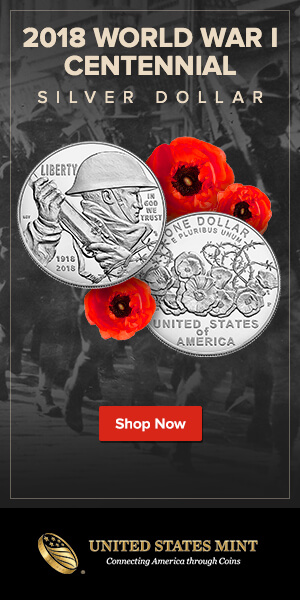
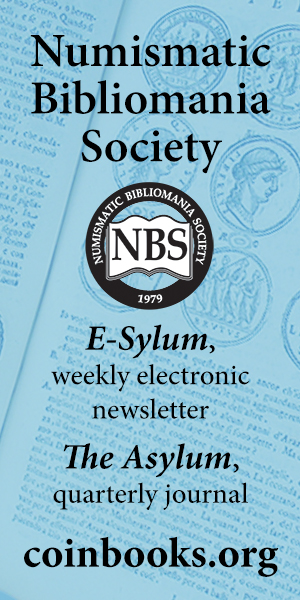
CANADIAN NATIONAL INSTITUTE FOR THE BLIND COIN
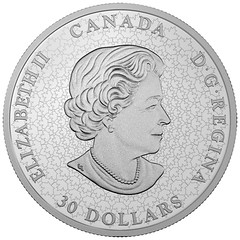
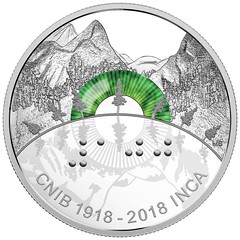
Working with a partially sighted artist and adding braille to a coin for the first time, the Royal Canadian Mint is proud to launch a finely crafted and innovative silver coin and bronze medallion set honouring the 100th anniversary of the Canadian National Institute for the Blind (CNIB). This limited-edition collector set celebrating a century of providing invaluable assistance to generations of blind and partially sighted Canadians can be ordered as of today.
The coin and medallion set was designed by Canadian artist Meghan Sims of Kitchener, Ontario. Born with a rare visual condition called Achromatopsia, she is fully colour blind. Her unique visual perception of the world around her has shaped and become characteristic of her artistic style.
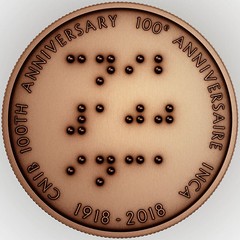
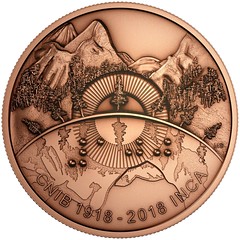
Since Mint collectibles are normally encapsulated to maintain their pristine condition, a medallion is included in this anniversary set, intentionally presented without a capsule, so that the braille engraving of the legend "CNIB-100-INCA", as well the entire relief of its design, can be experienced through touch alone. In providing a unique tactile experience, the medallion captures many of the design elements found on the reverse (or tails side) of the silver coin. These include: the number "100" engraved in braille; an abstract eye over a mountain scene to represent the foundation of the CNIB; and a curved horizon evoking an eyelid, along which seven jack pines honour each of the CNIB's founding members. The jack pine was chosen as a symbol of the strength and resilience of people living with sight loss.
The coin's obverse features the effigy of Her Majesty Queen Elizabeth II, designed by Canadian artist Susanna Blunt.
The 2018 $30 Fine Silver Coin And Bronze Medallion Set - 100th Anniversary of the Canadian National Institute for the Blind has a limited mintage of 3,000 and retails for $219.95. It is available for purchase by contacting the Mint at 1-800-267-1871 in Canada, 1-800-268-6468 in the US, or online at www.mint.ca. The set is also available at the Royal Canadian Mint's boutiques in Ottawa and Winnipeg, as well as through the Mint's global network of dealers and distributors, including participating Canada Post outlets.
To read the complete article, see:
The Royal Canadian Mint launches an innovative coin and medallion set honouring the 100th anniversary of the Canadian National Institute for the Blind
(https://www.newswire.ca/news-releases/the-royal-canadian-mint-launches-an-innovative-coin-and-medallion-set-honouring-the-100th-anniversary-of-the-canadian-national-institute-for-the-blind-677497223.html)
SCARINCI ON THE BREAST CANCER AWARENESS COIN
 What should have been an obverse coin design depicting women empowered in the fight against breast cancer instead became a design of women who are angry and in protest. There is a subtle
difference in expression between power and anger. Unfortunately, the US Mint got it wrong.
What should have been an obverse coin design depicting women empowered in the fight against breast cancer instead became a design of women who are angry and in protest. There is a subtle
difference in expression between power and anger. Unfortunately, the US Mint got it wrong.
This is the first time the public is seeing the result of the lack of leadership at the United States Mint following the retirement of Don Everhart, formerly in the modified Chief Engraver’s role. Virtually every senior level position at the Mint is occupied by someone with an “acting” status. Members of the Citizens Coinage Advisory Committee and other Mint insiders have seen problems of a leaderless Mint, but until now the public had little evidence of it.
Other than the final sculpt of the pink gold coin that was permitted to go into production, the announcement of a silver bullion “medal” program, and the set of horrible designs for the 2019 American Legion Commemorative Coins presented to the CCAC and the Commission of Fine Arts in March, the lack of permanence in the Mint’s leadership has been largely a “behind the scenes’ matter.
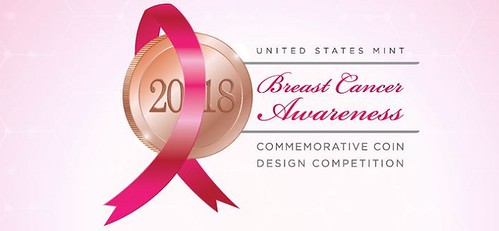
The Breast Cancer Awareness Commemorative Coins launched on March 15, 2018. The set includes the first pink-hued gold coins issued by the U.S. Mint. They are composed in 85% gold, 14.8% copper, and 0.2% zinc. The pink gold coin should have been a triumph of design and R&D.
Emily Damstra, a prolific coin designer for the Royal Canadian Mint and member of the United States Mint’s Artistic Infusion Program, presented a fine drawing to the special design Committee created by Congress to recommend designs for this coin. Her 2017 Boys Town Centennial dollar design was masterful.”
Phoebe Hemphill, one of the finest sculptor engravers in the world, who did the sculpt for the Breast Cancer Awareness coins did a masterful job of rendering the facial expressions of the two women and producing a coinable work of art.
Ron Harrigal, the United States Mint Design and Engraving Manager whose tenacity led the Mint to produce the first cupro-nickel curved Baseball Hall of Fame Commemorative that won Coin of the Year in 2015 and his team conducted extensive testing for optimal coloring and coining. He got it right and could have brought home another award-winning coin.
Any fault with the ultimate gold product that is being sold to the public does not lie with any of these people. If there is fault that must be assigned to what is happening at the US Mint right now, the fault lies with the delay by Congress to appoint a Mint Director.
A couple hours after writing the above words on Wednesday March 21, 2018, I read news that the Mint director position was once again filled. See the next article in this issue for more information. -Editor
To read the complete article, see:
US Mint Issues an Angry Breast Cancer Awareness Coin
(http://donaldscarinci.com/us-mint-issues-an-angry-breast-cancer-awareness-coin/)
DAVID J. RYDER CONFIRMED AS MINT DIRECTOR
Shortly after 4:00 p.m. today, David J. Ryder was confirmed once again as the director of the United States Mint. He was nominated by President Donald Trump and confirmed by a voice vote. The Mint has been without a formal director since the departure of Edmund Moy in 2011, making this an even more momentous occasion. Moy, the 38th Mint director, served from 2006 until the start of 2011, during which time he saw the institution through the crisis of the collapse of the housing market and the worldwide Great Recession. A few days after his January 1 departure, the Mint’s deputy director, Andy Brunhart, left to join the Bureau of Engraving and Printing. The Mint’s associate director for manufacturing, Richard Peterson, was hired as deputy director on January 25, 2017. In 2012, President Barack Obama nominated former auto executive Bibiana Boerio for the position of director, but her nomination died in committee. Mr. Peterson continued to serve as the acting Mint director until President Obama’s appointment of Rhett Jeppson on January 12, 2015. The Senate refused to vote on the appointment, so Mr. Jeppson served as principal deputy director until January 20 of this year, when he tendered his resignation.
A release from the White House Press Office describes David Ryder—who served as the 34th Mint director (September 1992–November 1993) under President George H.W. Bush—as follows:
David J. Ryder of New Jersey to be Director of the United States Mint. Mr. Ryder served as manager and managing director of currency for Honeywell Authentication Technologies. Previously, Mr. Ryder served as CEO of Secure Products Corporation, which was acquired by Honeywell in 2007. In 1991, Mr. Ryder was nominated by President George H.W. Bush and confirmed by the U.S. Senate to serve as Director of the U.S. Mint. His prior government service also included Deputy Treasurer of the United States, Assistant to the Vice President and Deputy Chief of Staff to Vice President Daniel Quayle. Mr. Ryder was born in Billings, Montana and raised in Boise, Idaho. A graduate of Boise State University, Mr. Ryder is married with two children.
To read the complete article, see:
David J. Ryder confirmed as director of the United States Mint
(http://mintnewsblog.com/david-j-ryder-confirmed-as-director-of-the-united-states-mint/)

WSJ QUESTIONS NEED FOR CENTS AND NICKELS
The Wall Street Journal ran an article early this week asking should cents and nickels be retired. The pros in favor, of course, was the fact they cost more to produce them than their face value. This is one more voice in the growing chorus in favor of dispensing with these coins.
Reasons on the con side in the WSJ article were rather weak, “they help create demand for more profitable coins in the cash economy.” To support this appeal they quoted experts who stated, among other things, the increasing demand for these denominations by commercial banks reflecting demand by the institutions who need these coins for commercial transactions, primarily retail outlets.
The need for these coins is because prices are quoted in multiples of cents. If cents and nickels were eliminated all prices would be rounded off to multiples of 10 cents. There would be no need for the two coins. Savings would be enormous for all.
Long time readers of The E-Sylum will recall I have been a proponent of eliminating not only the cent and the nickel, but also the quarter as well. Eliminate three coin denominations and replace these with three new coins for circulation, the dollar, $5 and $10 coins.
All fractional prices less than a dollar would be accommodated by the dime and half dollar. The rounding off of prices to a dime multiple would balance out over a period of time, both for the seller and he buyer. The argument this would raise prices is false, as numerous studies have shown.
More than 20 countries have eliminated one or more minor denominations, including Canada and Australia. America should do like wise.
While the U.S. government is not in the business of making profits—it is not in the “business” of anything, some would say—there is increasing political and economic pressure on Congress to do more to balance the government’s books. So is the place to start literally with pennies and nickels?
Henry Aaron, the Bruce and Virginia MacLaury senior fellow in the economic studies program at the Brookings Institution, says we should end the minting of pennies and nickels. Jay L. Zagorsky, an economist and research scientist at Ohio State University and a professor at Boston University’s Questrom School of Business, argues that the small coins still serve a big purpose.
To read the complete article (subscription required), see:
Should the U.S. Retire the Penny and Nickel?
(https://www.wsj.com/articles/should-the-u-s-retire-the-penny-and-nickel-1521425100)
PHILADELPHIA TOKEN PHASEOUT NEARS COMPLETION
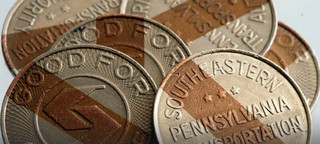 In a long-awaited move, SEPTA will discontinue token and TransPass sales at bus districts and Regional Rail once and for all by the end of April. Subway and bus token sales will be phased
out at select Regional Rail stations beginning March 23, according to SEPTA.
In a long-awaited move, SEPTA will discontinue token and TransPass sales at bus districts and Regional Rail once and for all by the end of April. Subway and bus token sales will be phased
out at select Regional Rail stations beginning March 23, according to SEPTA.
"This represents the next major move toward implementation of the SEPTA Key," SEPTA said earlier in March.
The Key is a card that can be loaded and reloaded with the user's choice of SEPTA transit fare, including weekly/monthly TransPass, one-day passes or money that can be used toward single rides.
Philadelphia is the last major U.S. city that still uses transit tokens. A token system had been in use in the city since at least the 1880s, according to the Philadelphia Inquirer.
For those who aren't ready to let go of their tokens just yet, SEPTA plans to continue selling tokens at 16 strategically-chosen stations until April 30.
To read the complete article, see:
Say Goodbye to SEPTA Tokens & Hello to SEPTA Key: Tokens Being Phased Out by the End of April
(https://www.nbcphiladelphia.com/news/local/SEPTA-Tokens-TransPass-End-Key-March-April.html)
To read the earlier E-Sylum article, see:
THE ART OF OBSOLETE SEPTA TOKENS (http://www.coinbooks.org/v21/esylum_v21n04a28.html)
BARRON'S ARTICLE HIGHLIGHTS ANDERSON PAPER MONEY
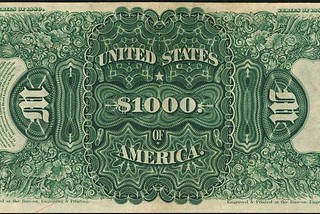 Renowned currency collector Joel R. Anderson is selling his never-before-seen collection of 240 U.S. banknotes valued at $30 million. The collection will be sold in several parts and holds
a number of historically significant bills.
Renowned currency collector Joel R. Anderson is selling his never-before-seen collection of 240 U.S. banknotes valued at $30 million. The collection will be sold in several parts and holds
a number of historically significant bills.
According to the auction catalog, Anderson who lives in Alabama and owns a numismatic publishing company as well as TNT fireworks, the largest firework distributor in the country, had a goal to obtain the finest-condition of every major large-size federal paper money design from the first widely circulated issues of 1861 to the 1920s.
U.S. currency was introduced in 1861 when the Union government realized that it didn’t have enough precious metal reserve in its treasury to fund the Civil War. As the U.S. is one of four nations never to have demonetized its currency—the U.K., Thailand and Canada, the others— it means that the notes can be used today for their face value no matter when it was issued. Not that anyone would want do that, as some of the rarer notes have estimates of up to $1.2 million, according to the auction catalogue.
Part of the appeal for collectors is how artistically conceived the notes are. As a way to instill confidence in the American consumer to induce them to accept paper payments instead of coin, the government created complicated designs that would be both difficult to copy and instill a sense of gravitas and purpose in paper. That is why there are portraits of people who held lofty positions in the government or treasury on the front of the bills—it was all to give the American people a sense of calm in the Civil War.
From a collector’s perspective, the ephemera of paper is another reason this collection is so attractive. “Currency is rarer than coins,” says Peter Treglia, director of currency of the Stack’s Bowers Galleries based in Santa Ana, California, which is in charge of the auction. “The stuff doesn’t last as long as coins, it gets weathered and damp and then it has to be pulped.”
Anderson has interesting finds sprinkled through the catalog. From 1880, there is a $2 bill with a signature of Mississippian Blanche Kelso Bruce—the first African-American who served a full term in the senate and a two-term Register of the Treasury (May 1881-June 1885 and December 1897-March 1898). He was also the first African-American to have his signature on the U.S. currency. The estimated value is $3,000 to $4,000.
To read the complete article (subscription required), see:
Rare Paper Money Collection Worth $30 Million to Be Auctioned
(https://www.barrons.com/articles/rare-paper-money-collection-worth-30-million-to-be-auctioned-1521498249)
ARTICLE PROFILES BLAIR, NB $10 NATIONAL BANK NOTE
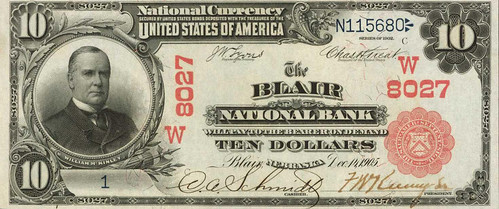
A $10 bill went a long way in 1905.
Just to get some perspective, a 10 spot at the turn of the 20th century would be equivalent to $270 in 2018. Today, that's half a month’s rent, a weeks worth of groceries or one exceptionally bad hand at the blackjack table.
It's a lot of money, but it's peanuts when compared to how much a 1905 $10 bank note from Blair might bring at auction this week.
The $10 bill was recently found in an estate in San Francisco, Calif. There's only speculation as to how it wound up so far from home. What is known is it was handed down from an in-home nurse who worked in the Beverly Hills area.
"We think the most likely thing would be that the person she was caring for came from Blair and either had no relatives or had a special connection with this caretaker," said Manning Garrett, the director of currency auctions for Stacks Bowers Galleries, which is handling the sale.
The note is exceedingly rare according to Garrett, who said its value stems from multiple factors.
"It's kind of a perfect storm of desirability," he said.
It is one of two notes in existence from the Blair National Bank, which opened in 1905 and operated for 10 years. At that time any "national bank" could issue their own currency.
"Some banks, like let's say the National Bank of New York City, issued millions of bank notes and today you can buy one for $40," Garrett said. "But a bank like Blair was serving a much smaller community, so they needed a fraction of the bank notes to meet demand."
The first note that was found from Blair was auctioned in 2009 and sold for just over $12,000. It was what is known as a "blue seal" note, referring to the color of the seal on the bill itself. Blue seal notes were issued from 1908 to 1928. The note up for sale Friday is a red seal, which were only issued from 1902 to 1908, making it much more collectable than the note that was sold in 2009.
The bill is in pristine shape. The red seal is as bright as the day it was issued and the bottom of the bill is signed by the bank's cashier and president in the immaculate cursive everyone from that era seemed to have. These signatures add to the rarity.
"When banks first opened, bankers were of course very proud of their money and they'd take the time to individually sign each bank note," Garrett said. "But at a certain point, you'd get tired of signing every note so a lot of banks would have a stamp of their signature made up."
On Friday, the bill will be auctioned live in Baltimore and simultaneously online and via phone. Garrett said many of those vying for the bill will be local collectors.
“Most collectors specialize in a state,” he said. “So, you’re going to have collectors from Nebraska looking to add a note from Blair to their collection.”
The starting bid for the note is $7,500. It has an estimated value online of $12,000 to$17,000. But Garrett said if the right two or three collectors are interested in this piece, the final bid could be upward of $40,000.
To read the complete article, see:
115-year old Blair bank note to be auctioned
(http://www.enterprisepub.com/news/local_news/year-old-blair-bank-note-to-be-auctioned/article_6fa776d2-2c43-11e8-a2fc-ab00a9de0d3c.html)
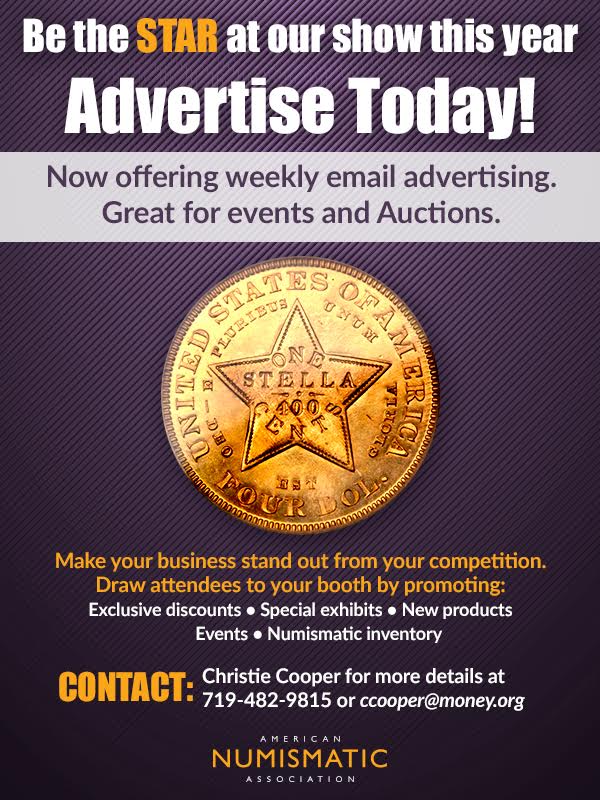
VENEZUELA PONDERS DROPPING THREE ZEROS
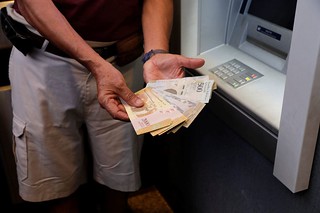 President Nicolás Maduro late Thursday briefly outlined his monetary rescue plan. In a country where a dozen eggs can cost 250,000 bolivars ($5) amid worsening inflation, he would chop
three zeros off the currency — arguably bringing the price for those eggs down to 250.
President Nicolás Maduro late Thursday briefly outlined his monetary rescue plan. In a country where a dozen eggs can cost 250,000 bolivars ($5) amid worsening inflation, he would chop
three zeros off the currency — arguably bringing the price for those eggs down to 250.
“I ask you all for your prayers and support for the success of the monetary reconversion,” Maduro said in a televised event Thursday night.
The move came as Henri Falcon — a former governor running against Maduro in elections set for May — is proposing a far more radical fix. He wants to follow the path of countries such as Ecuador and Panama by dollarizing the Venezuelan economy. Doing so, he says, would prevent the printing of new bills — instantly constraining inflation.
Socialist Venezuela is going through a crisis that has left people struggling to pay for food and find medicines. Prices are being influenced by a black-market exchange rate that rises by the day and is currently five times the nearly inaccessible official rate.
Customers are standing in hours-long lines at banks to take out a daily limit, set so low that it barely covers the price of a cup of coffee. Larger transactions are done by bank card or transfer — although some vendors are charging double for electronic payments.
Maduro’s redenomination plan was met with serious skepticism by critics and analysts, who say that the impact on hyperinflation would be minimal — and that the plan would be confusing. By June 2, under Maduro’s plan, new bolivars with lower denominations would be circulated — but old ones, with denominations as high as 100,000, would remain valid. It would leave vendors charging two prices — one for old bills, the other for the redenominated bolivar.
“Taking out three zeros doesn’t in any way solve any of the causes of hyperinflation,” said Jean Paul Leidenz, senior economist at Caracas-based Ecoanalitica. “It’s just a cosmetic fix that won’t work.”
To read the complete article, see:
Venezuela hopes to tackle the world’s
worst inflation by deleting zeros from its currency
(https://www.washingtonpost.com/news/worldviews/wp/2018/03/23/venezuela-hopes-to-tackle-the-worlds-worst-inflation-by-deleting-zeros-from-its-currency/)
After the presidential announcement of a monetary reconversion that will come into force on June 4, the president of the Central Bank of Venezuela, Ramón Lobo, presented the family of bills that make up the "Sovereign Bolivar" " .
The new Bs 2, 5, 10, 20, 50, 100, 200 and 500 bills and the Bs 0.5 and 1 coins leave behind the so-called "Bolívar fuerte", in an attempt by the Nicolás Maduro government to provide "a new monetary cone with greater purchasing power ".
To read the complete article, see:
Lanzan un “Bolívar Soberano” en busca de “mayor poder adquisitivo”
(http://sumarium.com/gobierno-abre-paso-a-un-bolivar-soberano-en-busca-de-mayor-poder-adquisitivo/)
IN OTHER NEWS: MARCH 25, 2018
SS Central America: Science and Patience
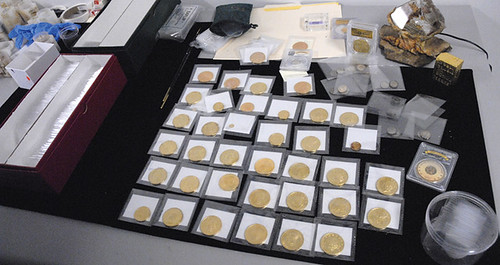
Evans makes it clear that each coin does not get the same amount of treatment. Though the solution is the same strength, some coins require more time for it to work, so some patience is required. Evans briefly relates a little about the chemistry of the solution being used to soak the coins free of the geologic deposits they acquired from their long stay on the seafloor, prior to their long-awaited display.
To read the complete article, see:
An in-depth look at the SS Central America: Science, patience, and
more gold coins (https://www.coinworld.com/news/us-coins/2018/03/in-depth-look-ss-central-america-science-patience-more-gold-coins.html)
Latest Craze: Old Photo Colorization
Adding color to historical black-and-white images isn’t a new phenomenon, but in recent years, a community of artists has emerged online as interest in their work has surged. In 2012, Danish artist Mads Madsen shared a portrait of a military general named Gershom Mott in full color, from the gleaming brass buttons on Mott’s uniform to the salt-and-pepper tones in his beard. The photograph looked as though it could’ve been a modern-day reproduction—yet the original was shot in 1864 during Mott’s service in the American Civil War, decades before the advent of color photography and more than a century before it became commonplace. As the photo made its rounds on Reddit, over a thousand commenters chimed in, many noting not only the image’s realism, but also the way it just seemed uncannily lifelike compared to static, black-and-white archival images from the era. “I love how colorized photos enable me to imagine these guys walking around today,” one commenter remarked. “I feel like I saw this guy at the store,” wrote another.
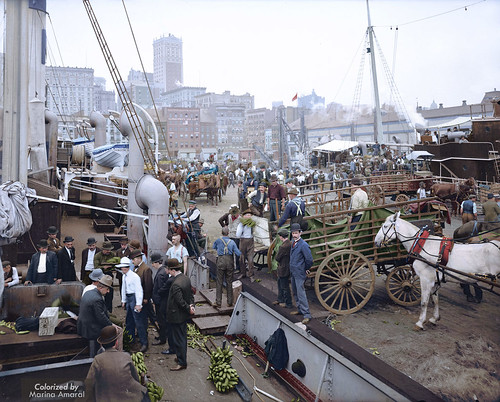
Banana docks, New York, ca. 1890-1910. MARINA AMARAL
Amaral regularly receives messages from strangers thanking her for helping them gain a better understanding of historical images after seeing her work. “I’d say that’s the best compliment I can receive,” she says. Madsen, too, has heard from people who “are not really history fanatics, but have started enjoying history on a deeper level once they’ve seen colorization and how it affects the human mind,” he says. That’s not to say there isn’t backlash: Madsen says the artists are occasionally accused of “defiling” history, though he and his fellow artists see their work as more of a complement than a replacement. (For what it’s worth, color photography elicited its own fair share of raised eyebrows back in the day.)
While purists may take umbrage at the idea of reworking history, there’s no question that these images have a powerful effect. Madsen describes black-and-white images as “sort of alien” in how they feel like relics from a bygone era. In grayscale, a historical photograph can feel trapped under museum glass. When color is added, Madsen says, everything changes. Wars waged, leaders assassinated, a nation’s greatest moments of pride and disgrace — color doesn’t just make these images attractive or more palatable. It throws its subjects’ humanity into high relief and forces us to see historical events as things that happened in real life to real people, not events that unfolded in the chapters of a history textbook. “Suddenly, it’s right there in front of you,” Madsen says. “You can almost feel it.”
To read the complete article, see:
The Passionate Photo Colorizers Who Are Humanizing the Past
(https://www.atlasobscura.com/articles/colorized-historical-photos)
Bill Gross Selling Stamp Collection
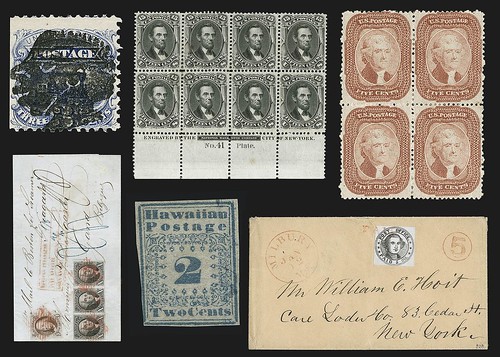
Bill Gross gained fame as the bond king. Now he rules the market for collectible stamps. His $42 million collection of U.S. postage is so comprehensive that when the first part of it comes up for auction in September, the entire field of philately will feel the effect.
“There’s never been a collection in private hands of U.S. material like the one Bill Gross put together,” says Cheryl Ganz, curator emerita of the Smithsonian National Postal Museum in Washington, which got more than $10 million from Gross’s family to build the William H. Gross Stamp Gallery, the world’s largest gallery dedicated to postage. “He went for the best of the best in every case.”
To read the complete article, see:
Bond Guru Bill Gross Is About to Rattle Another Market: Stamp Collecting
(https://www.bloomberg.com/news/articles/2018-03-07/bond-guru-bill-gross-to-sell-42-2-million-stamp-collection)
1952 Mickey Mantle Baseball Card Offered
After retiring from the NFL a little more than a year ago, Evan Mathis decided to move closer to where he grew up in Alabama.
And to get the kind of house he and his wife wanted, Mathis needed to free up some money. And that meant the avid sports card collector would have to part with his prized possession: a 1952 Mickey Mantle baseball card.
"Just that image of the young Mickey Mantle, over the years it's been a centerpiece of the hobby," Mathis told The Associated Press by phone. "I guess it's kind of like the Mona Lisa of the sports card world."
Issued as part of its first set of baseball cards by Topps, the Mantle card is the marquee piece of a card-only spring collection by Heritage Auctions. It is one of six versions of the card to have been rated a Mint 9 by PSA, one of the leading sports memorabilia authenticators, with three others having earned a Mint 10 rating.
The card has been estimated by Heritage to be valued at $3.5 million. For comparison, the highest price paid for a card at auction was $3.12 million two years ago for a 1909 Honus Wagner card.
To read the complete article, see:
Ex-NFL lineman Evan Mathis selling prized Mickey Mantle card
(http://abcnews.go.com/Sports/wireStory/nfl-lineman-evan-mathis-selling-prized-mickey-mantle-53984144)
Dumb questions? Not really
Experienced collectors and dealers have pretty much all been asked what might be construed as dumb questions about coins or paper money by non-collectors.
There are hundreds, if not thousands, of such questions, but here are a few examples:
“How much is the gold worth in these gold dollars?” (referring to the Native American and U.S. Presidential dollars issued this century that are yellow in color but do not contain a speck of gold content despite the U.S. Mint’s marketing campaign calling them Golden Dollars).
“What is this really old coin worth?” (which could be a currently circulating coin that was minted in the 1980s or 1990s, something that might actually seem really old from the perspective of the child asking the question).
“Can you give me $1,000 in currency for this $1,000 coin?” (which could be a coin from Mexico dated before that country dropped three zeroes from their money in 1993, where the coins use the dollar sign to signify pesos, hence coins that depict “$1000” now have an exchange value just over five cents in U.S. money).
Take a moment and think about the best way to respond to what might be considered dumb questions if someone asks you one.
Sure, it would be easiest to give a quick answer of the item just being current spending money, a fake, a replica or counterfeit, a token or medal, or a minor coin or currency of virtually no value (whichever may be the circumstance).
But what difference would it make if the collector or dealer were to take a little more time to acknowledge that the person was being intelligent by seeking information on the item and its possible value, then go on to share some background numismatic information that just might spark the interest of a new collector?
To read the complete article, see:
Dumb questions? Not really (http://www.numismaticnews.net/article/news/dumb-questions-not-really)
A Tour of NGC
To read the complete article, see:
A look behind the scenes of the Numismatic Guaranty Corporation
(http://www.coinsweekly.com/en/News/A-look-behind-the-scenes-of-the-Numismatic-Guarantee-Corporation/4?&id=5251)
FEATURED WEB PAGE: VIET NAM NUMISMATIC CLUB
This week's Featured Web Page is the Viet Nam Numismatic Club Facebook group.
https://www.facebook.com/groups/228335820625128/

